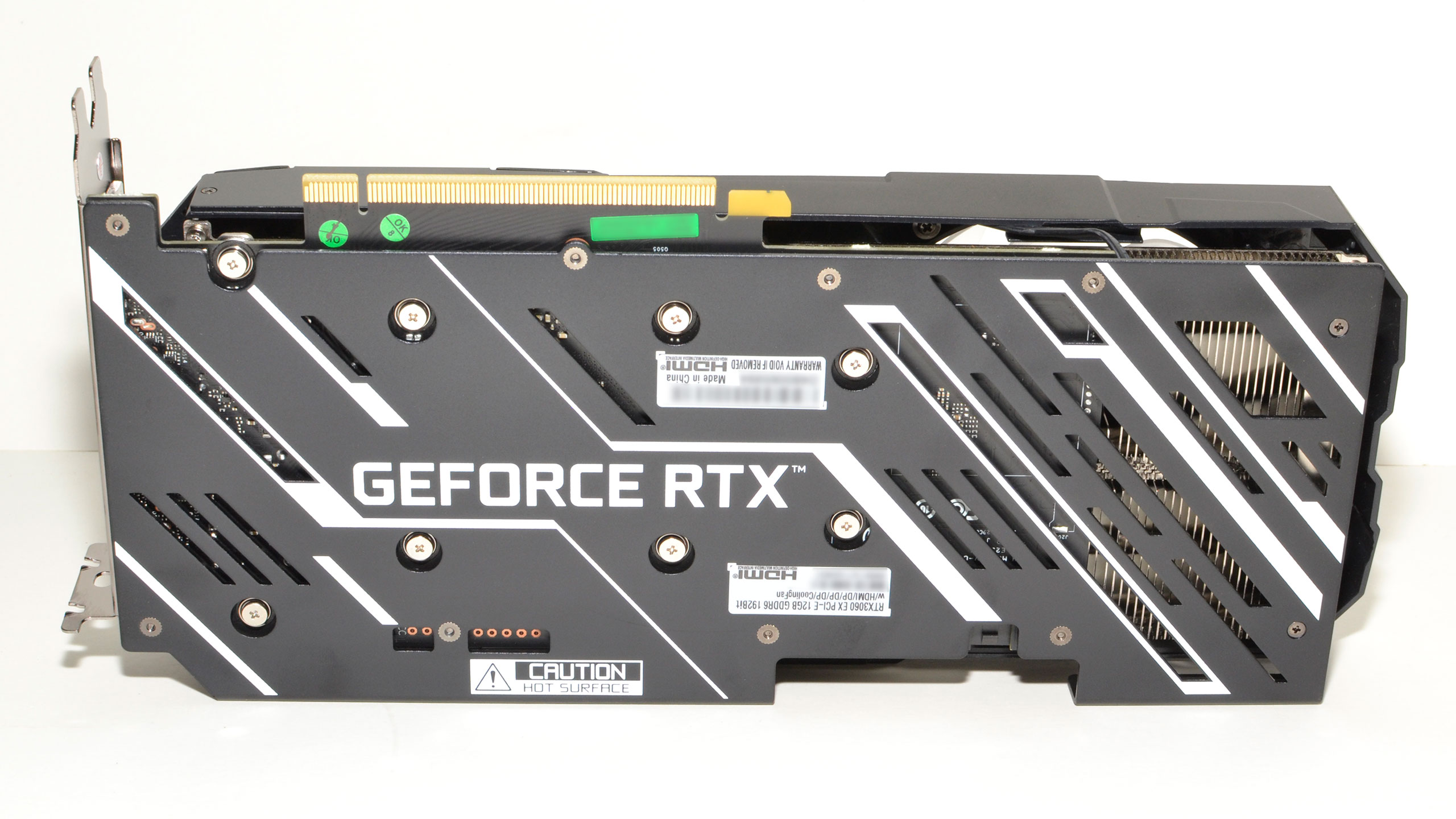Why you can trust Tom's Hardware
Galax RTX 3060 1080p Gaming Performance
Like the RX 6600 and RX 6600 XT, the RTX 3060 works best for 1080p gaming, and maybe 1440p. That's for more demanding games, of course, so lighter fare like esports games or anything that's more than a few years old should run quite well at higher resolutions. Performance from the RTX 3060 tends to be a bit higher than the previous-generation RTX 2070, and just behind the RX 5700 XT (not accounting for ray tracing or DLSS). Here's how the Galax looks, compared to the EVGA reference clocks as well as other mainstream to high-end GPUs. You can see the full rankings for the various cards in our GPU benchmarks hierarchy.
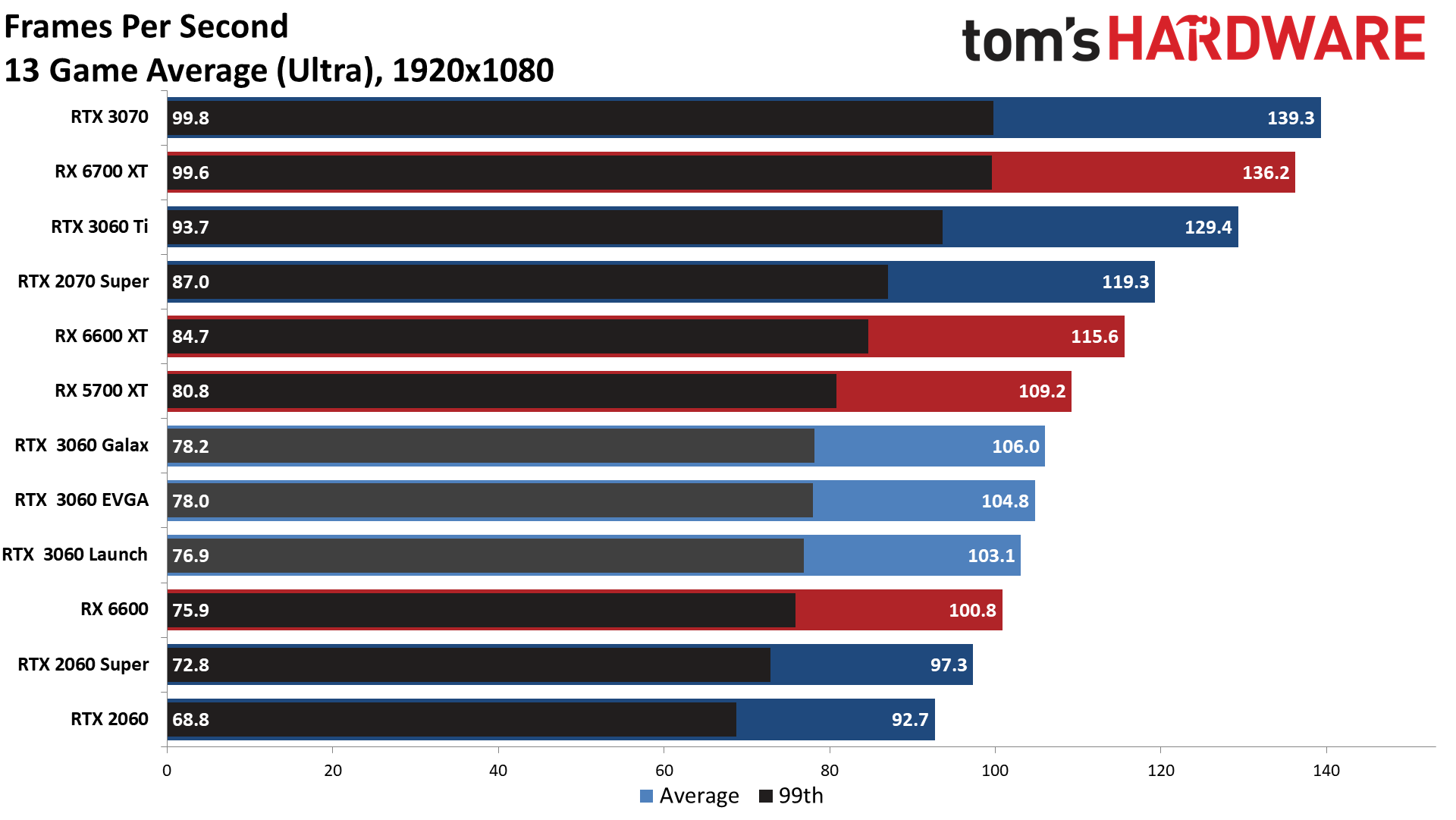
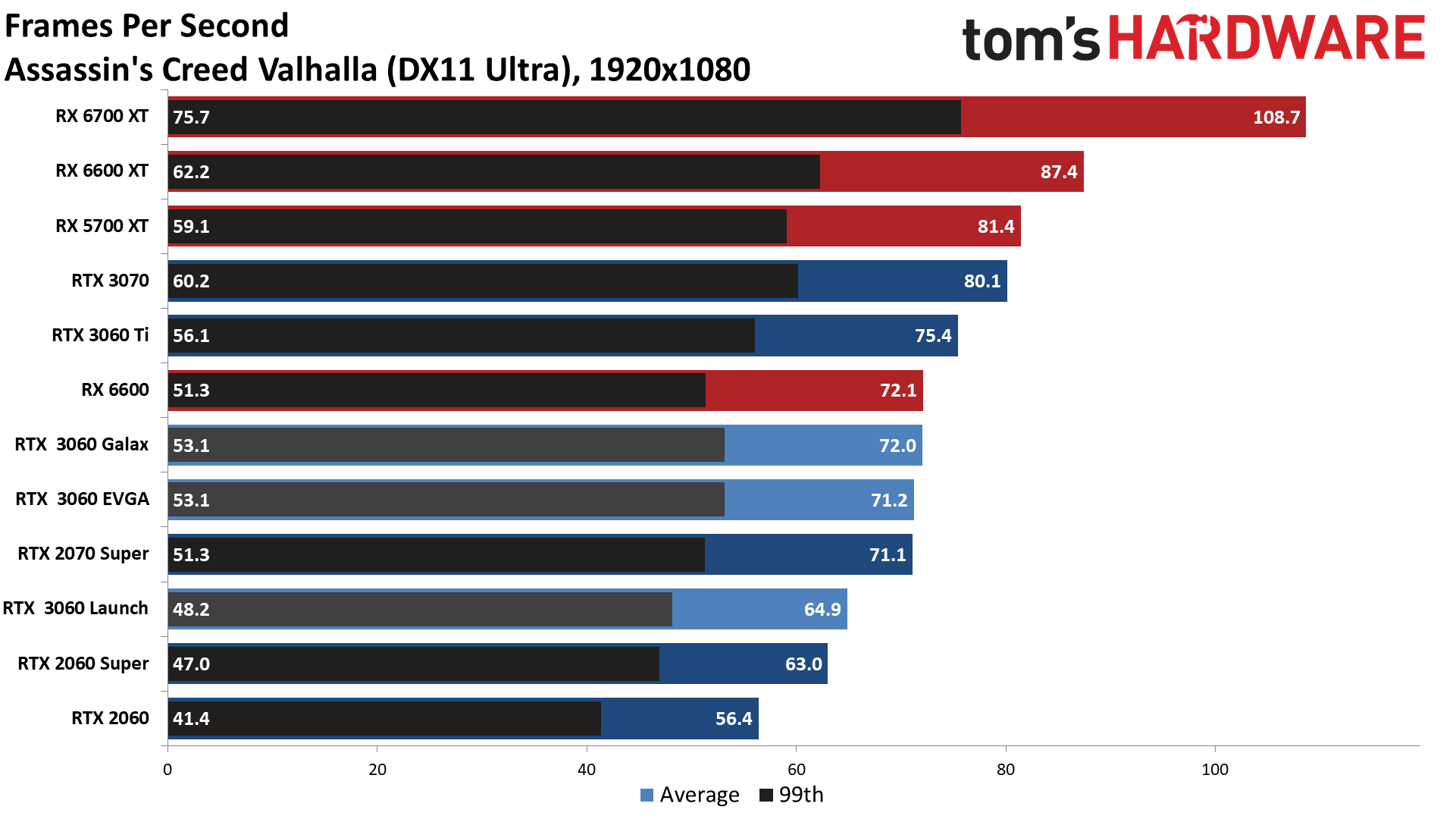
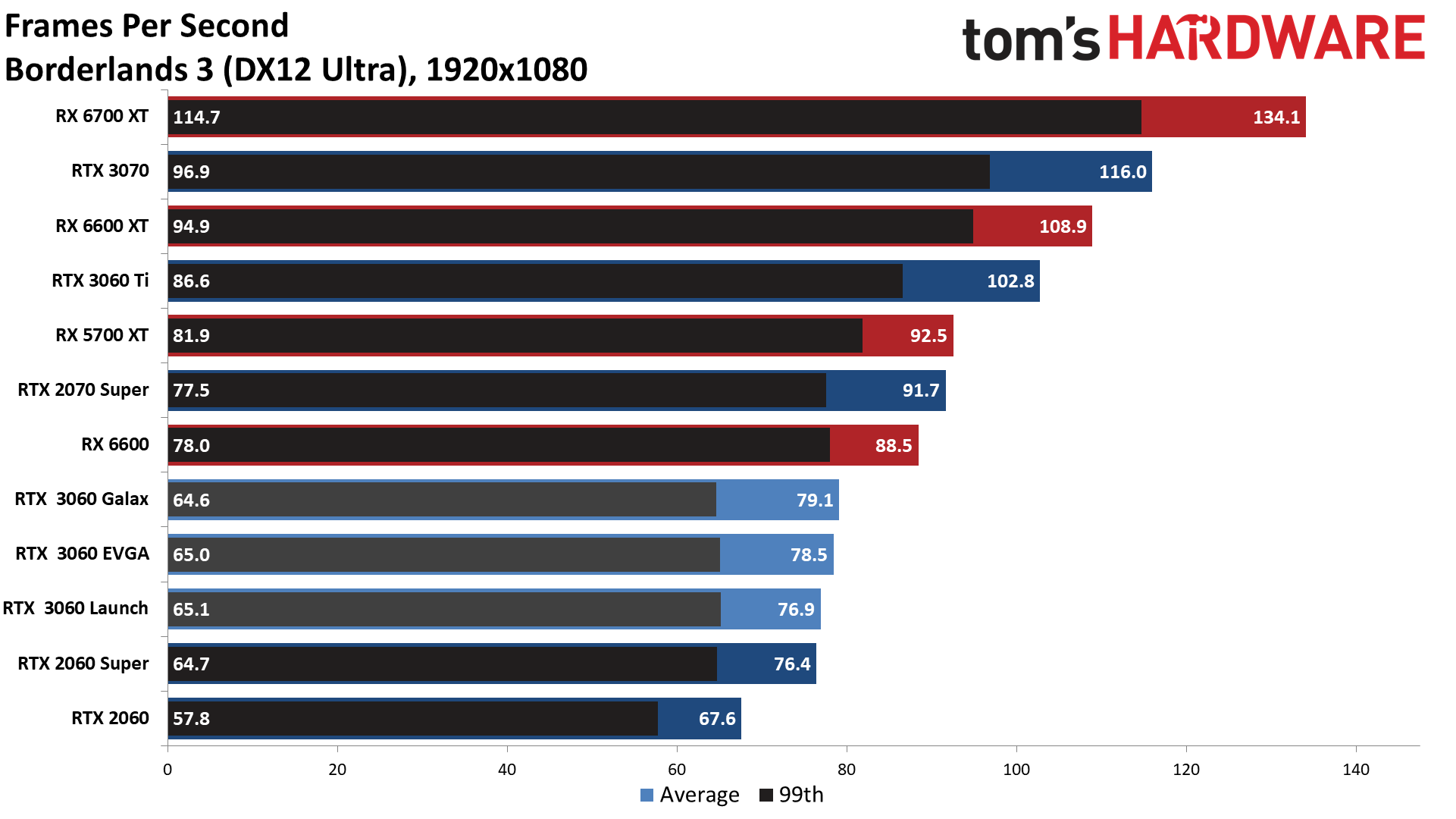
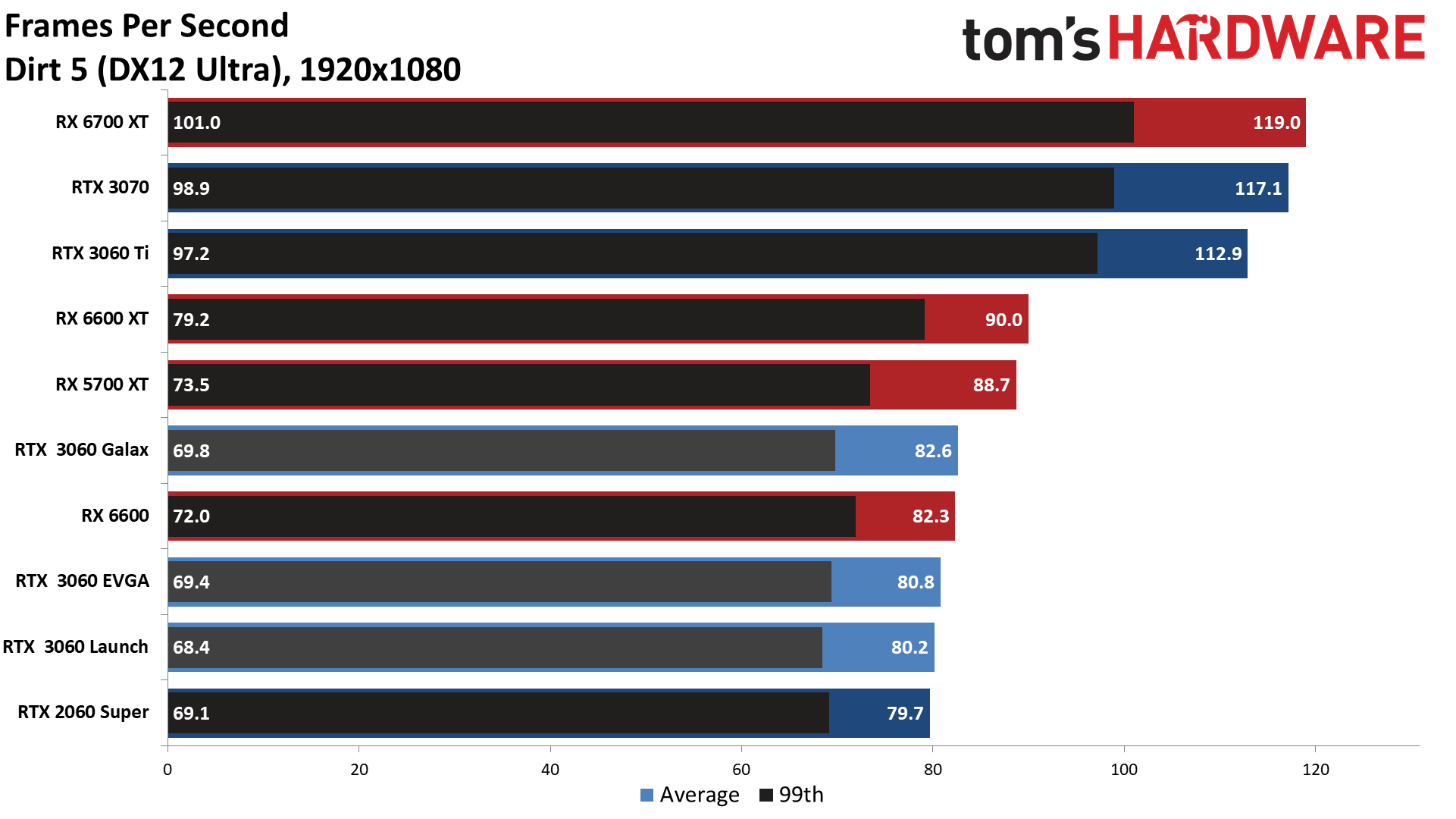

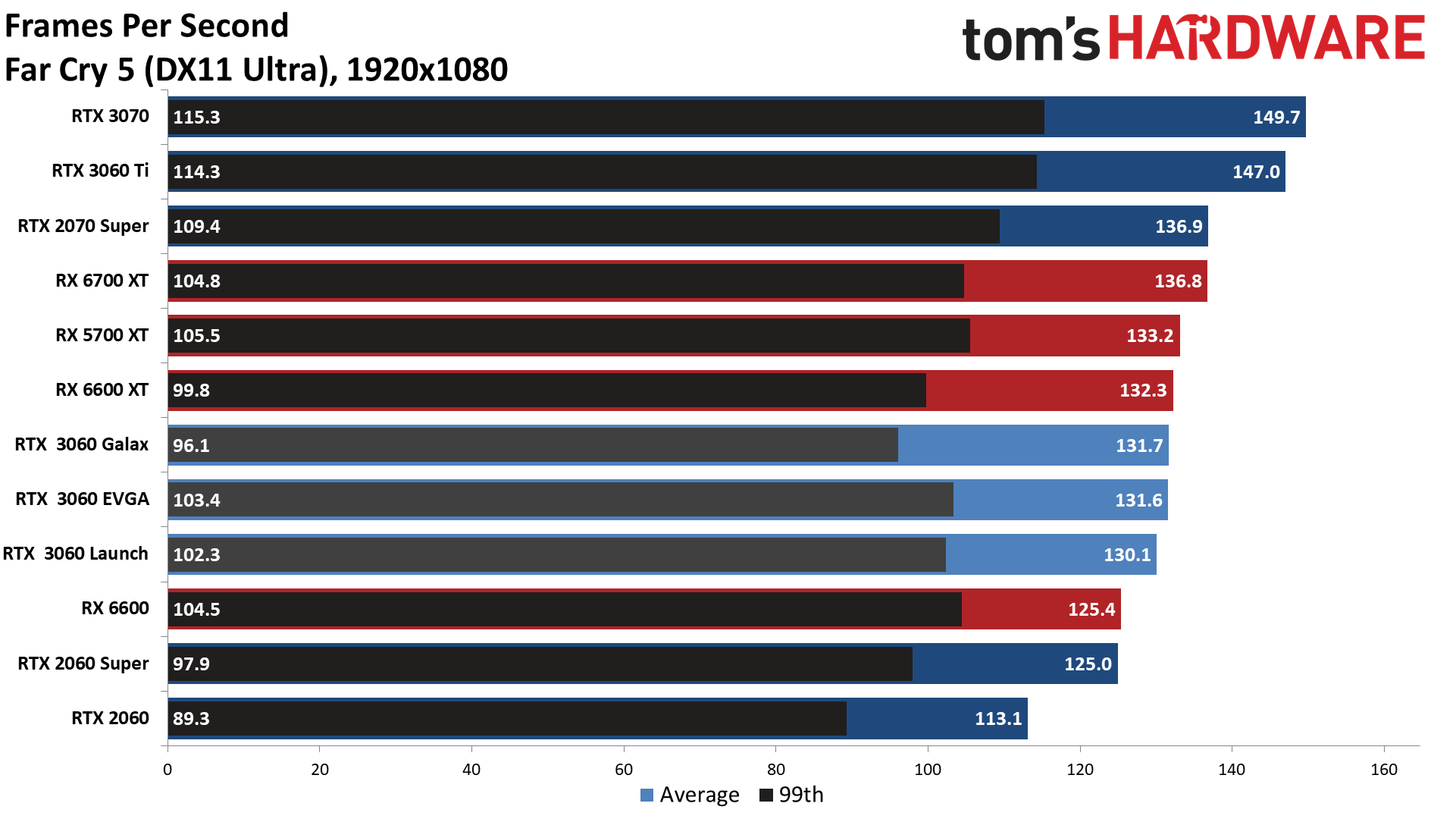
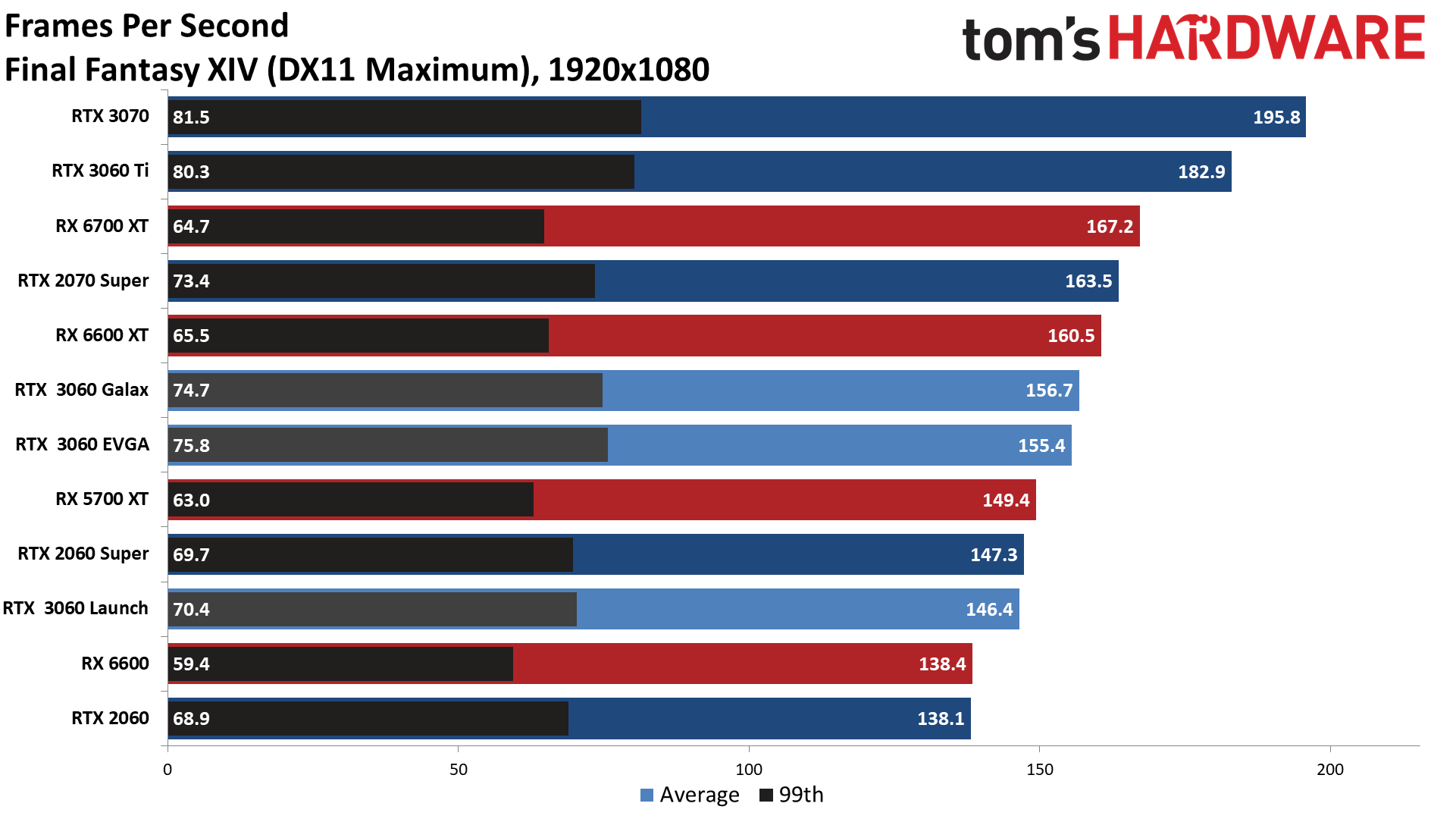




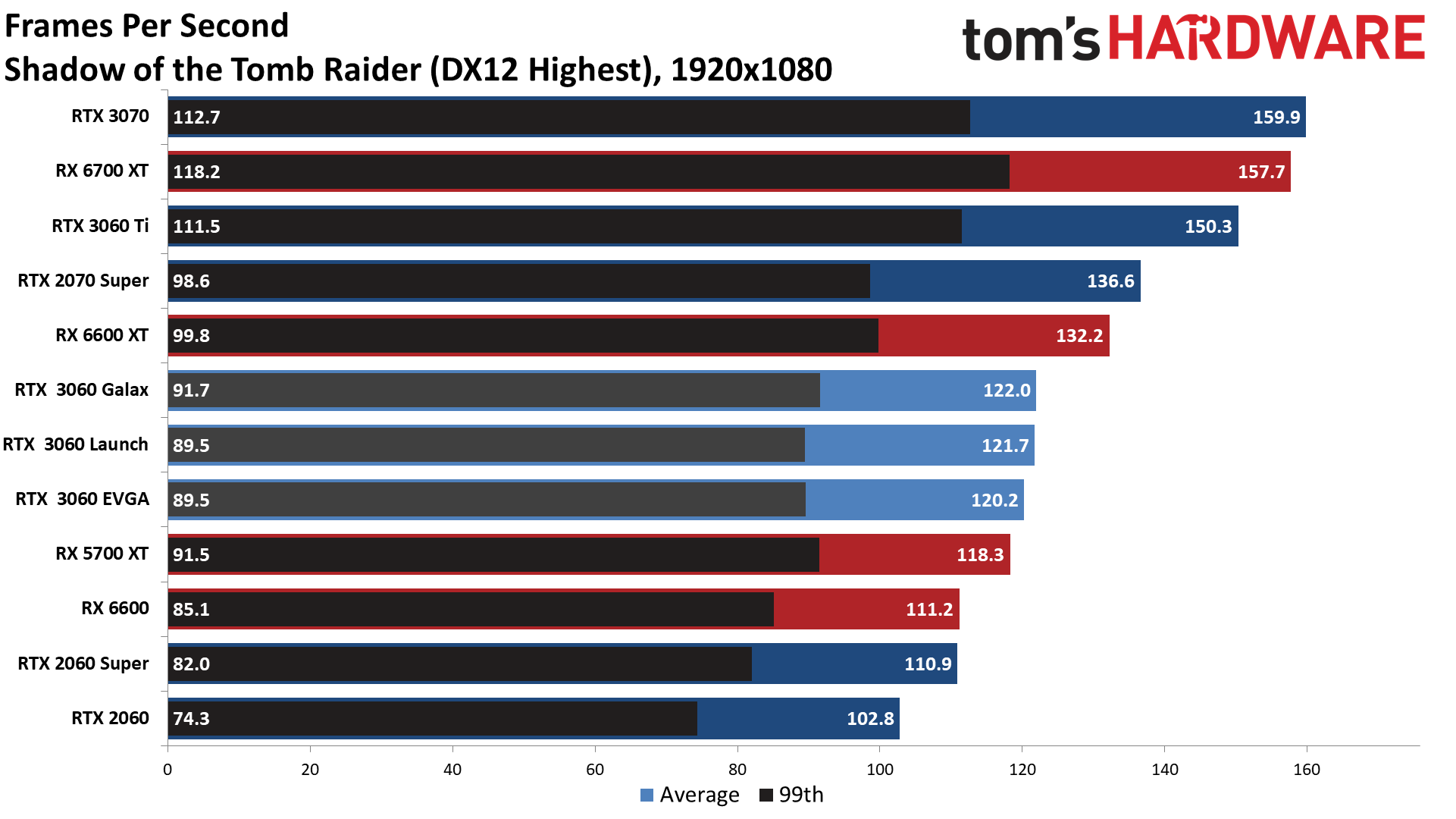
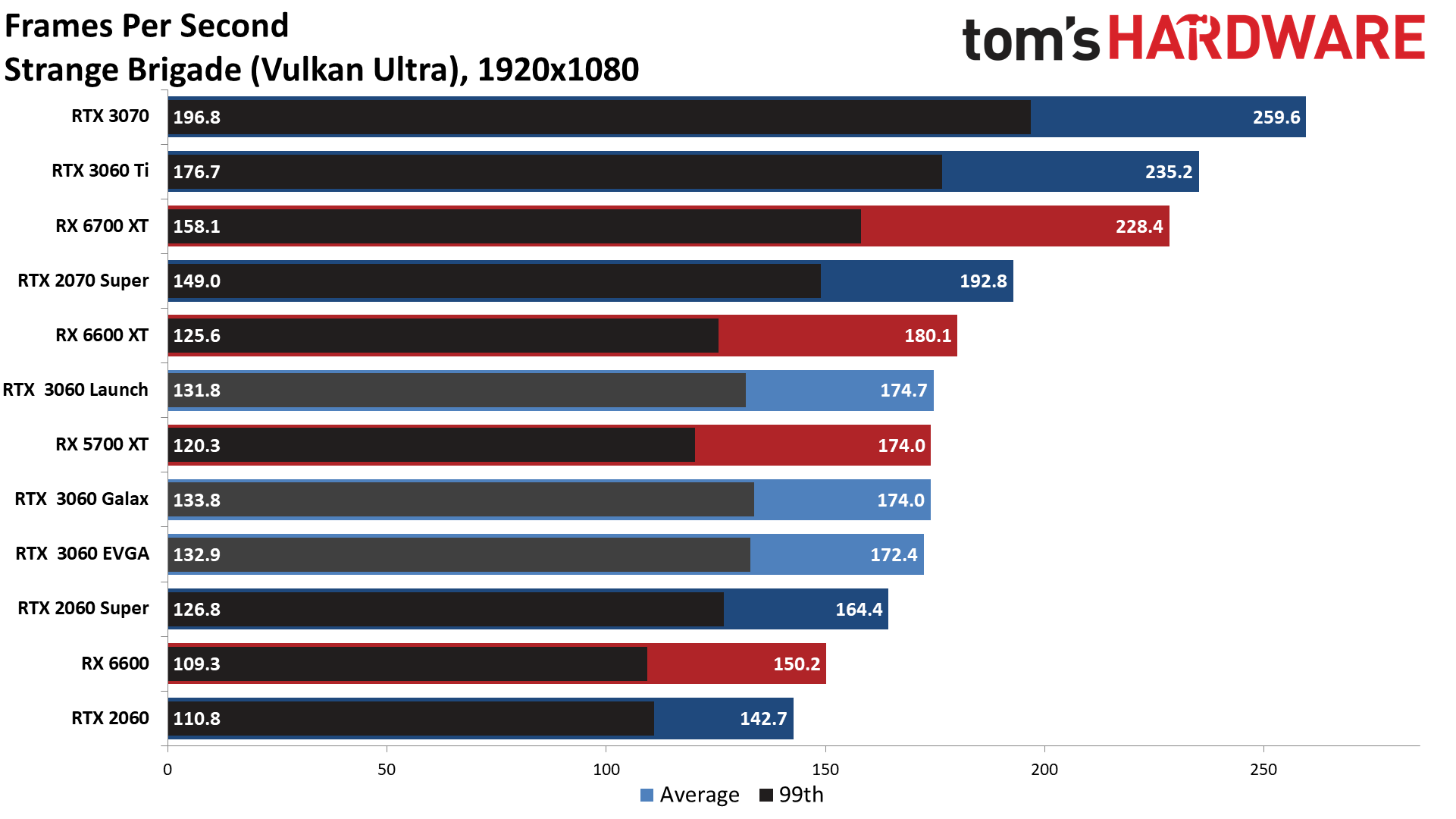

We've got three entries for the RTX 3060 in the charts, and you can see how things have — and haven't — changed since launch. Overall performance of the Galax card ended up being just 1% faster than the EVGA card running the latest drivers and updates, while the EVGA card improved about 2% over the past eight months. The RTX 3060 also comes in ahead of the similarly priced RX 6600, but behind the RX 6600 XT. The overall score tends to hide some of the bigger differences, though.
Assassin's Creed Valhalla favors AMD's GPUs by quite a bit, but Nvidia's driver updates have narrowed the gap some — the EVGA card for example improved by 10% since launch. Forza Horizon 4 improved by 6% as well, while most of the remaining games showed less than a 2% change. Several games performed a bit slower as well: Metro Exodus, Red Dead Redemption 2, Shadow of the Tomb Raider, Strange Brigade, and Watch Dogs Legion were all 1–3% slower than at launch, though we didn't try to determine whether that's from drivers or game patches. Using the latest drivers, the Galax and EVGA cards perform within about 2% of each other in every one of the tests, which is what we expected to see.
As for AMD vs. Nvidia, the Galax card only ended up noticeably behind the XFX RX 6600 in two games: Borderlands 3 and Forza Horizon 4. It was tied or led in the other 11 games, giving it a net 5% victory. Against the RX 6600 XT, however, it's a net 9% deficit, and an even larger 18% deficit compared to the RTX 3060 Ti. Unfortunately, while the RTX 3060 Ti has an MSRP of $400, in practice it tends to sell for closer to $800–$900, while the RX 6600 XT 'only' costs about $600–$650. That's actually less than the going rate on the RTX 3060, so unless you can find a reasonable deal on the Nvidia card, AMD ends up being the better buy right now (provided you're not concerned with ray tracing or DLSS).
Galax RTX 3060 1440p Gaming Performance


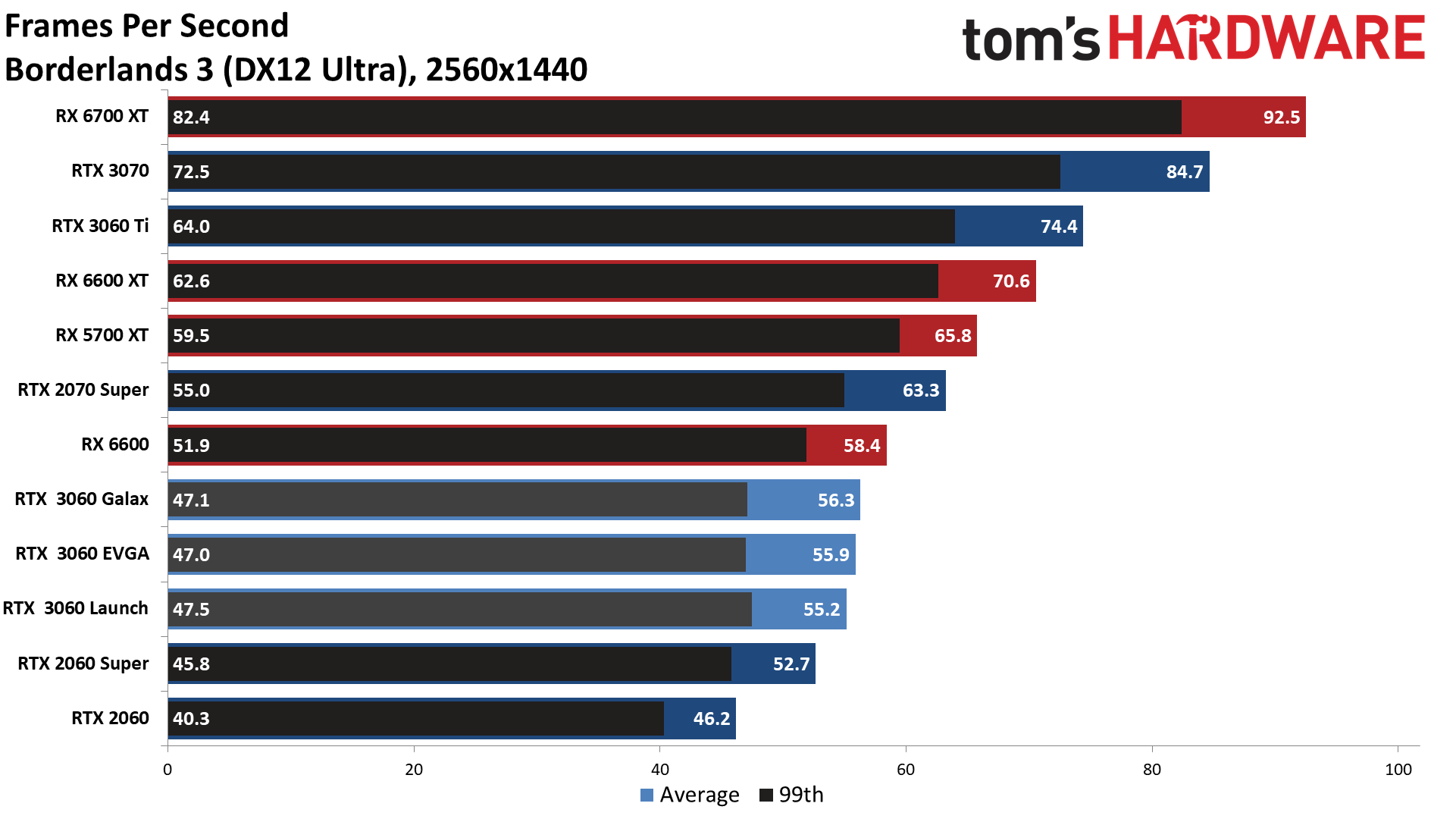



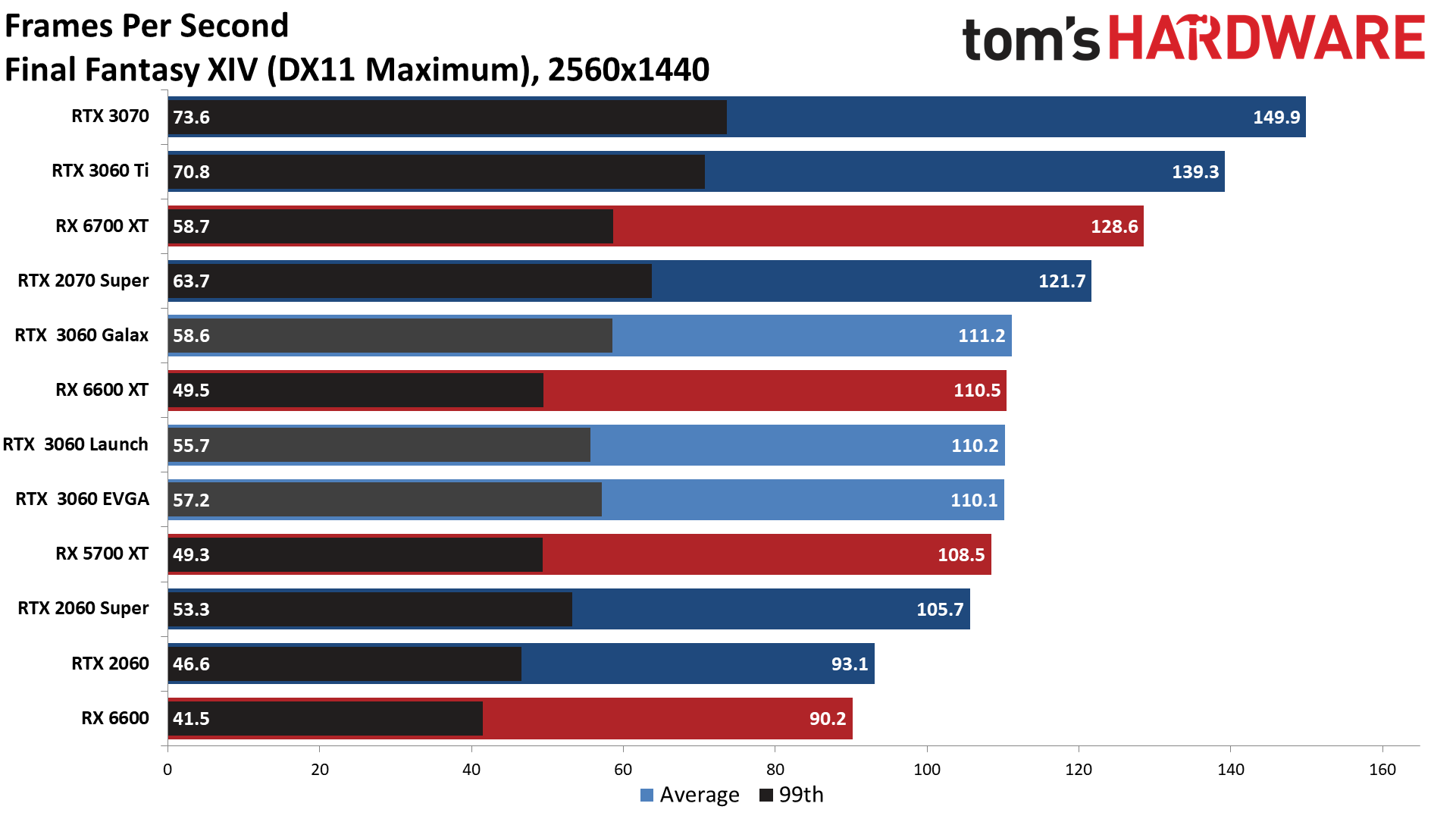
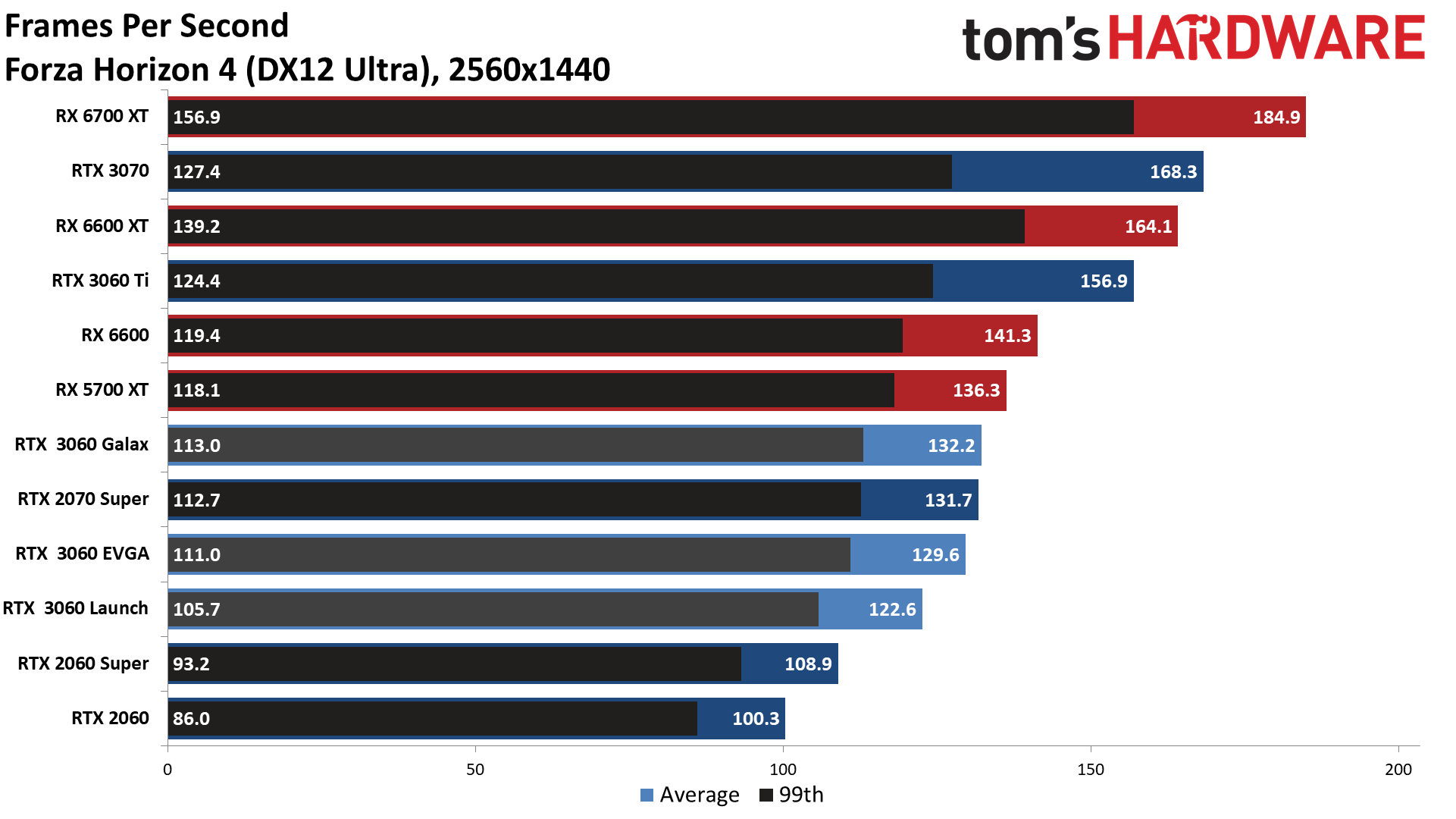
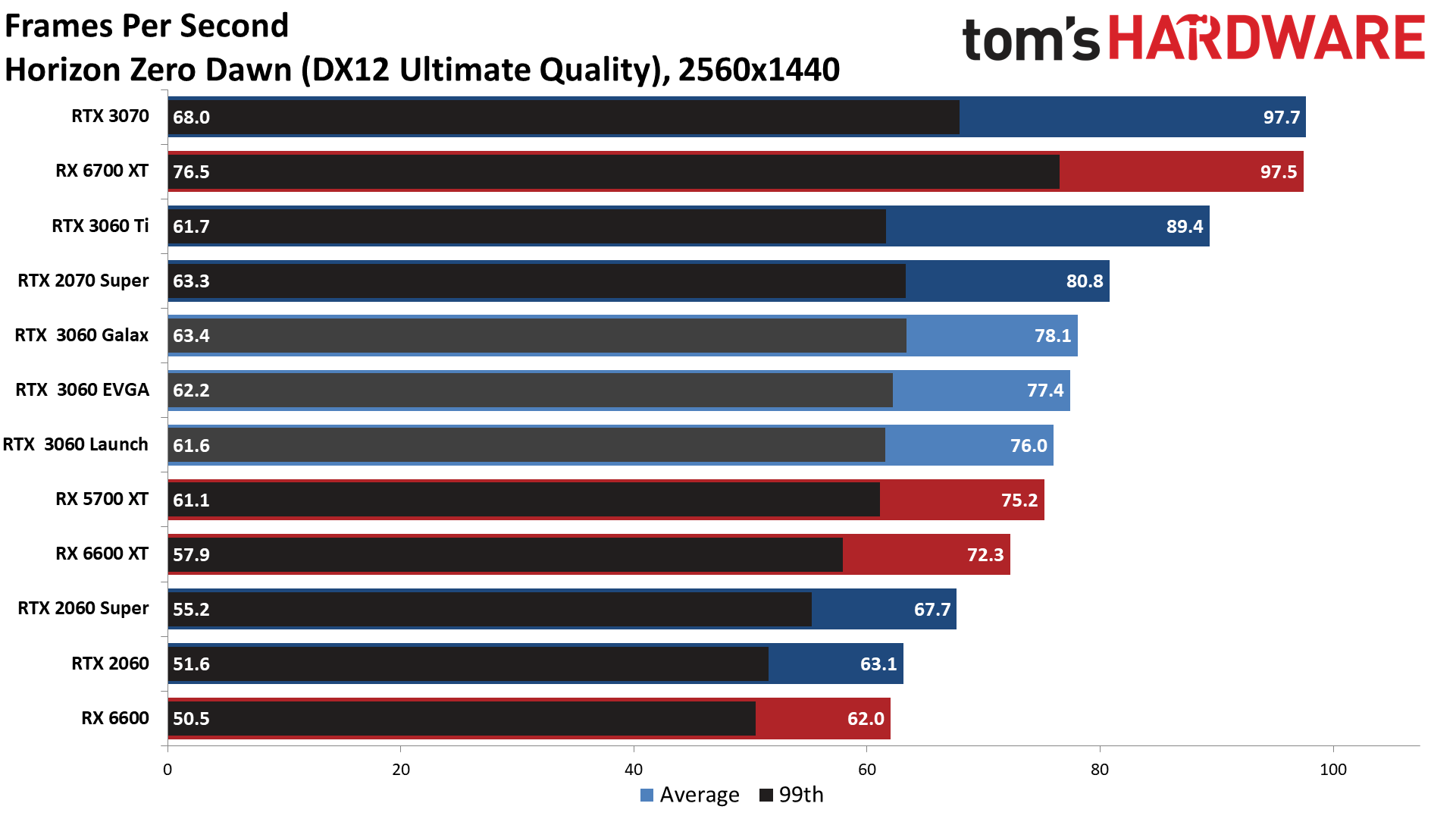
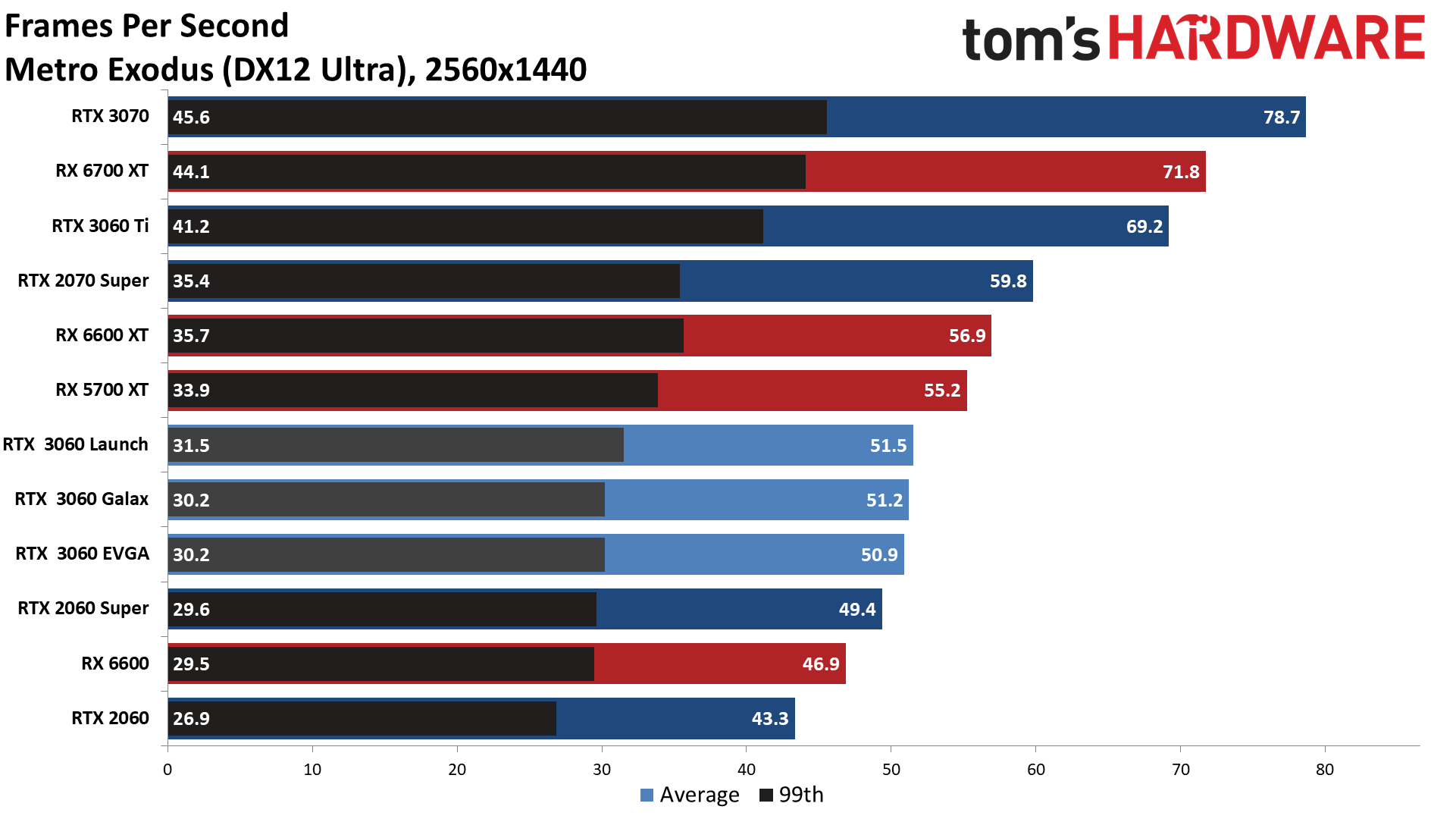

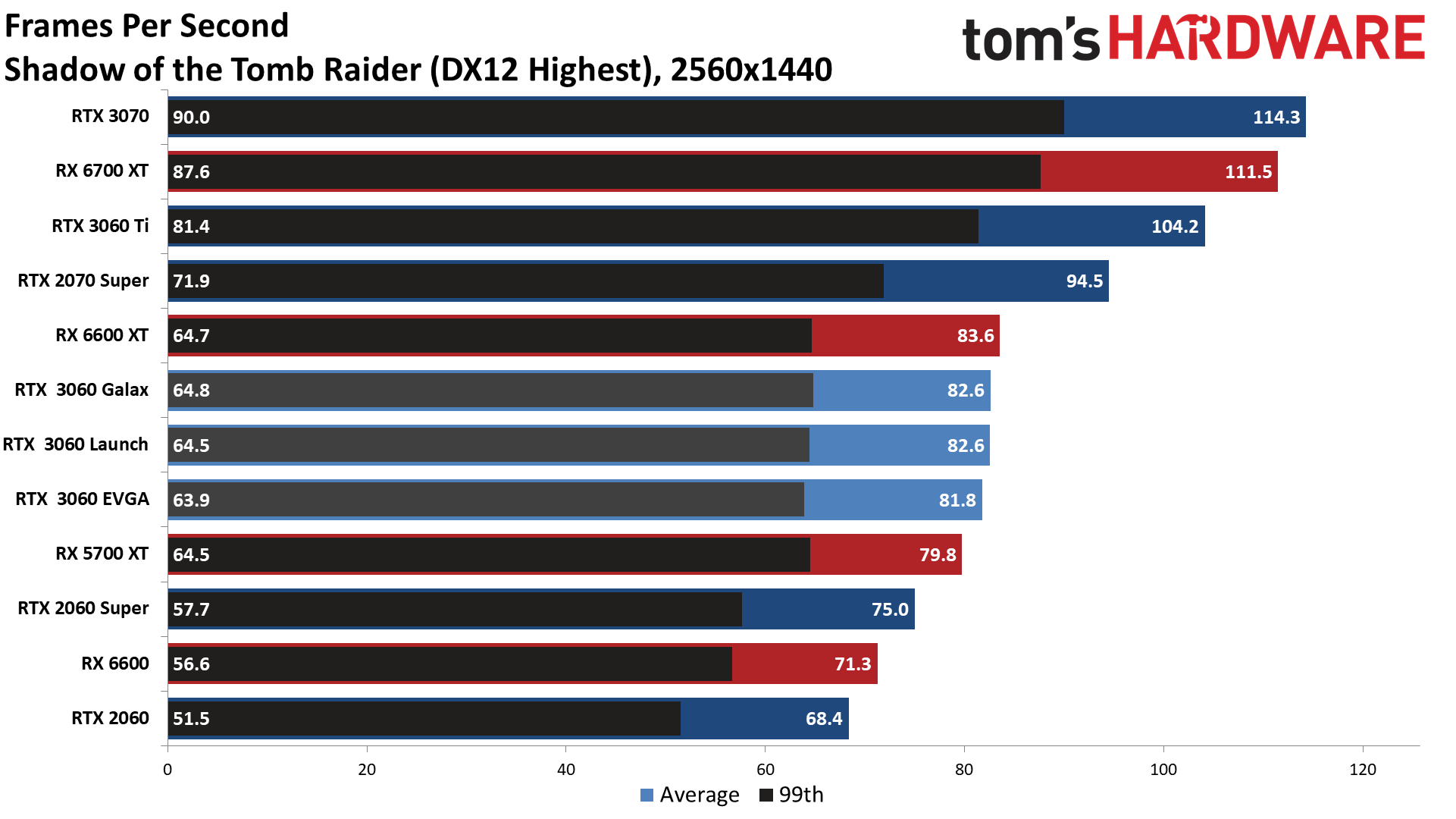
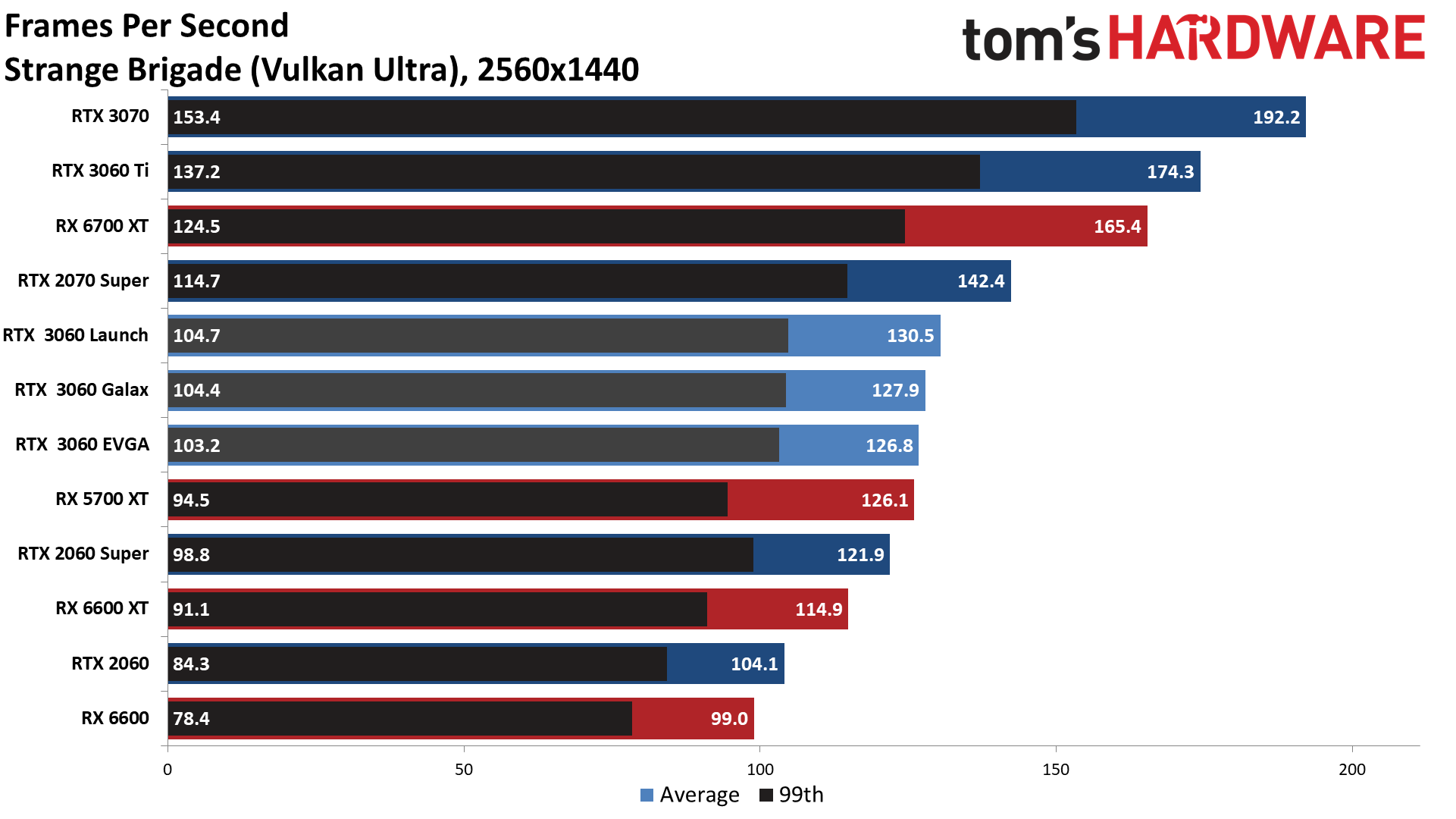
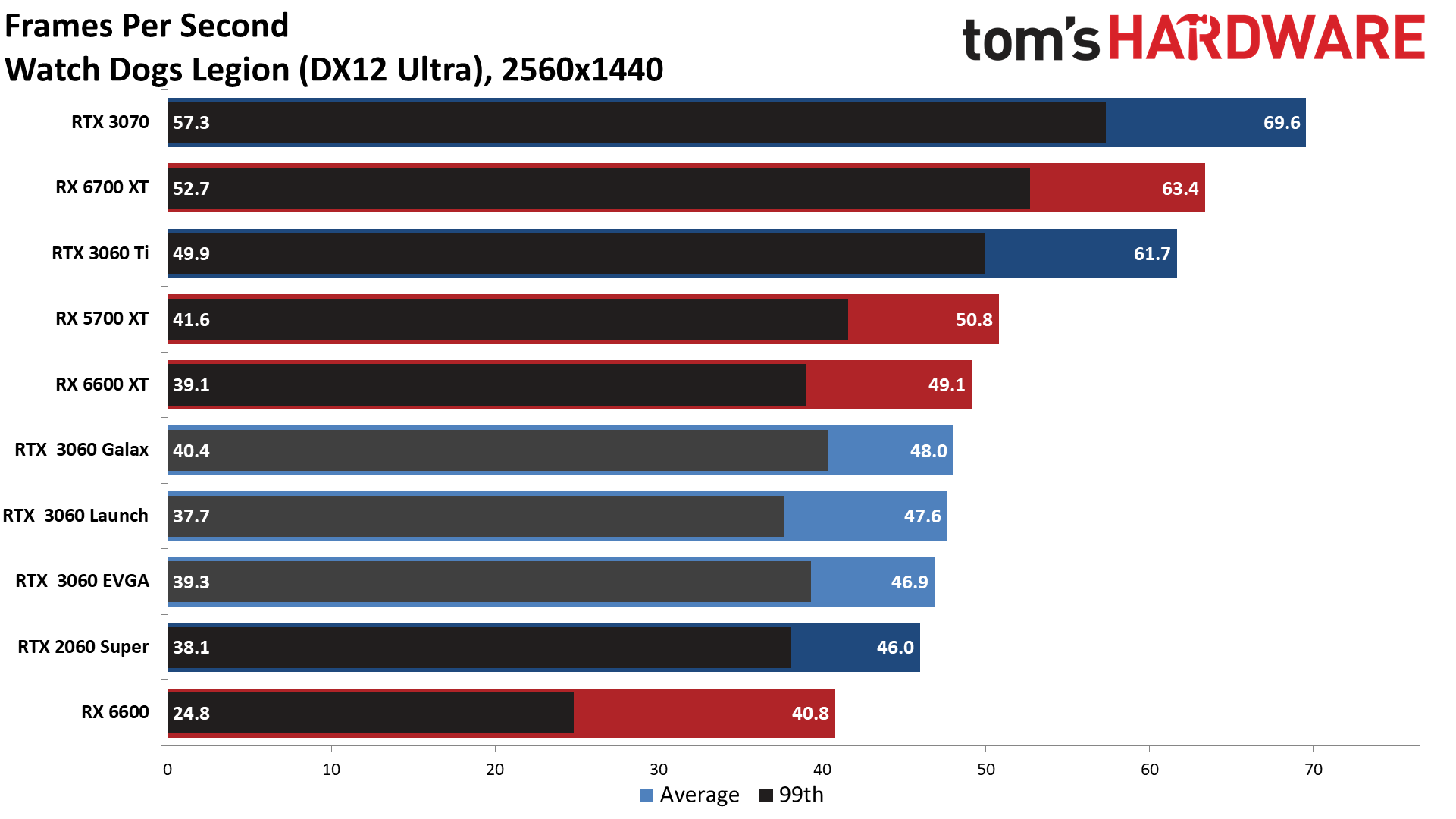
Running games at 1440p will often require tuning the settings a bit to maintain 60 fps on a GPU like the RTX 3060. Five of the games we tested fall below 60 fps at ultra quality settings, but only one of those (Watch Dogs Legion) was below 50 fps. Using high quality settings should get most of those over the hump, and a few of the games support DLSS, where the quality mode should boost performance by at least 15%. Maintaining a steady 60 fps or more — meaning, keeping the minimums above 60 — might be a bit more difficult in some games, but the RTX 3060 generally gets close enough that it shouldn't matter.
Looking at the Galax and EVGA cards, Galax comes out 1–3% ahead in the individual game tests, with an average lead of 1.2% — not something you'd notice in normal gaming, in other words. Performance improvements since launch averaged just 0.7%, with Valhalla and Forza being the only games to see more than a 2% improvement in framerates, while the same five games as before showed a slight regression of 1–3%.
Nvidia's RTX 3060 lead over the RX 6600 grew to 11% overall, and only Borderlands 3 and Forza had AMD leading, by 4% and 7% respectively. Seven of the games gave the Galax RTX 3060 more than a double-digit percentage lead over the XFX RX 6600. Were the cards actually selling for the same price, it wouldn't even be a close competition, but of course they're not priced the same. The Galax card also trails the RX 6600 XT by 6% overall, and the RTX 3060 Ti by 21%, so it's not just VRAM capacity helping the RTX 3060 relative to the AMD GPUs.
Galax RTX 3060 4K Gaming Performance
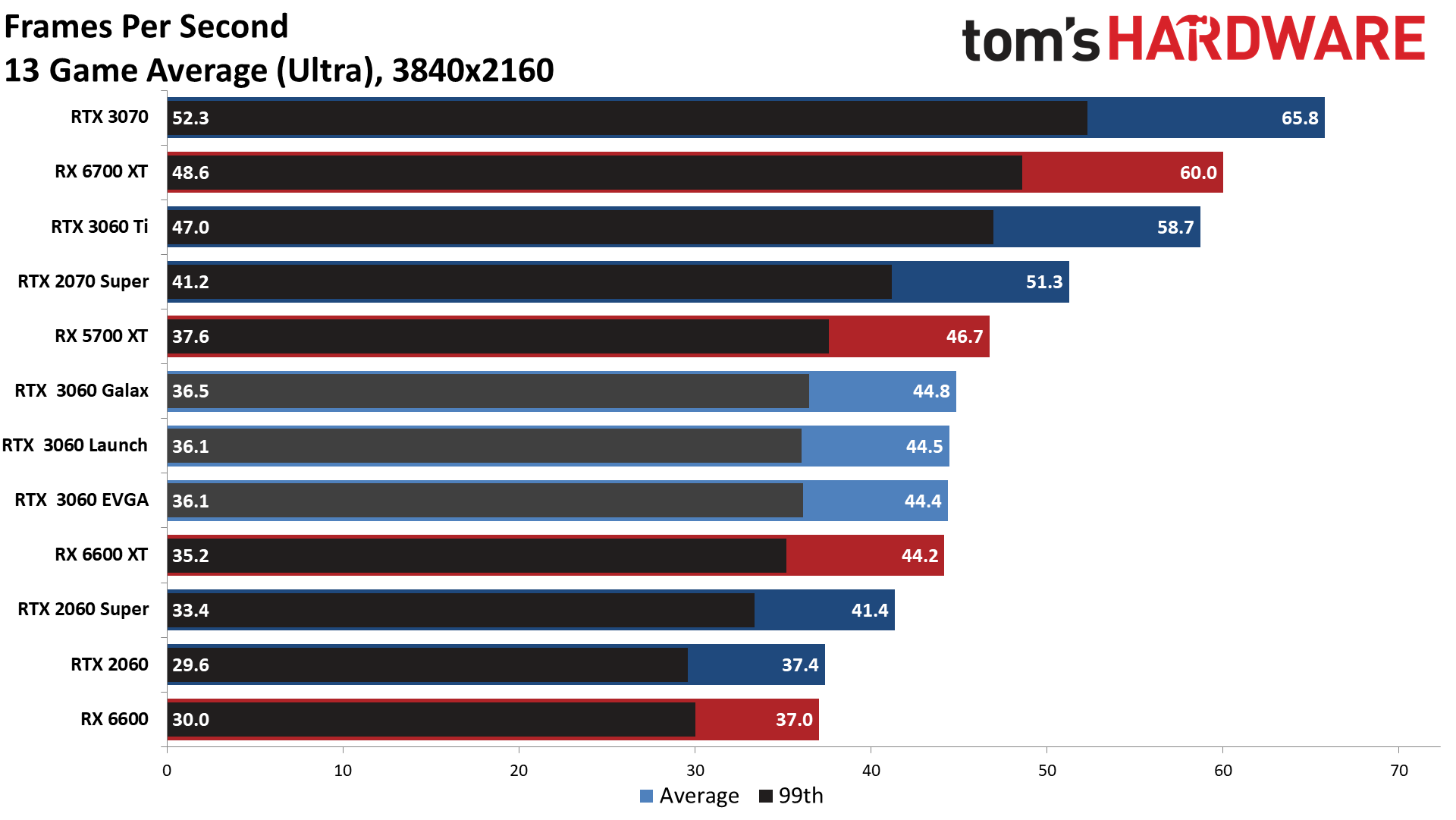
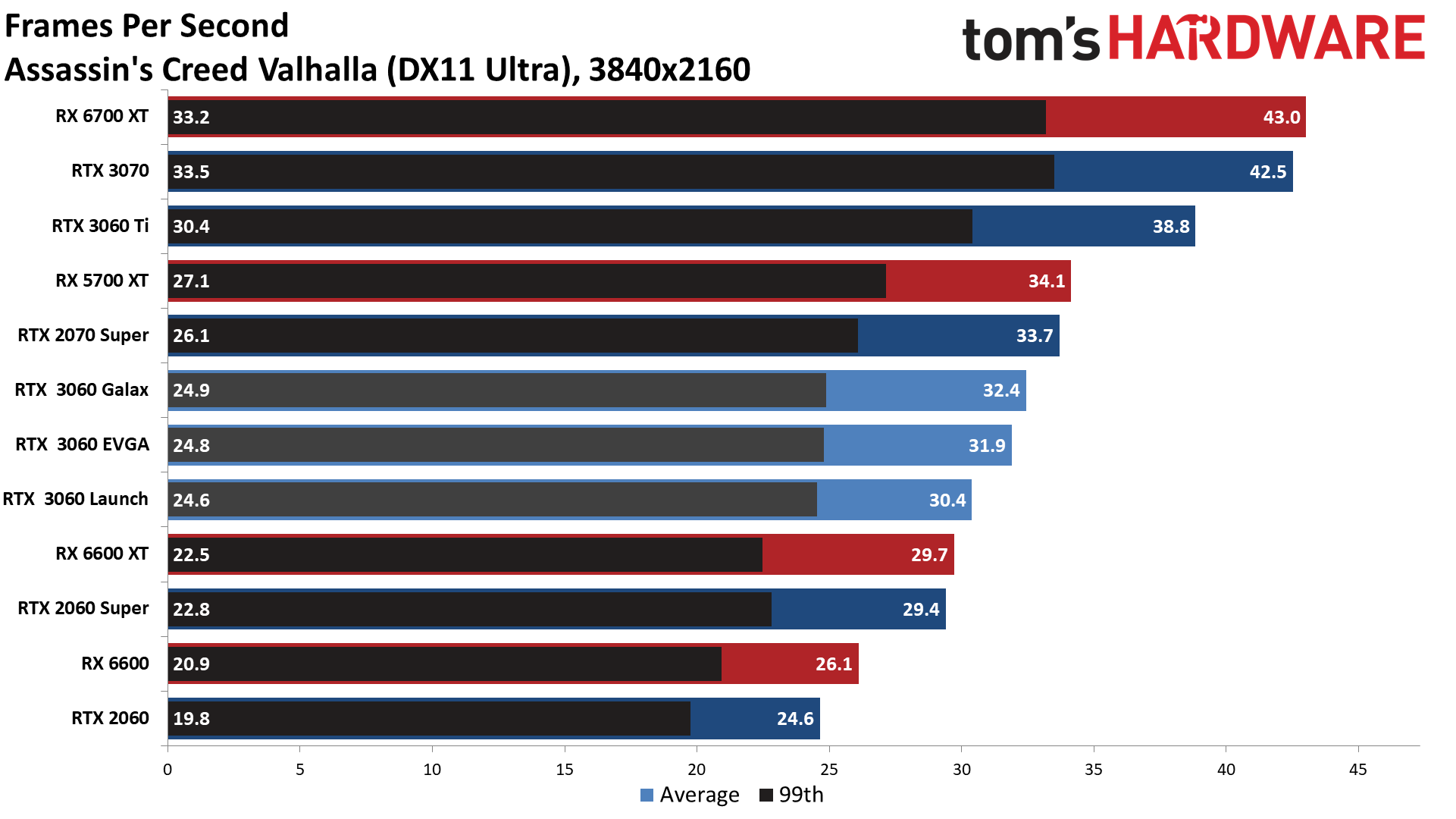
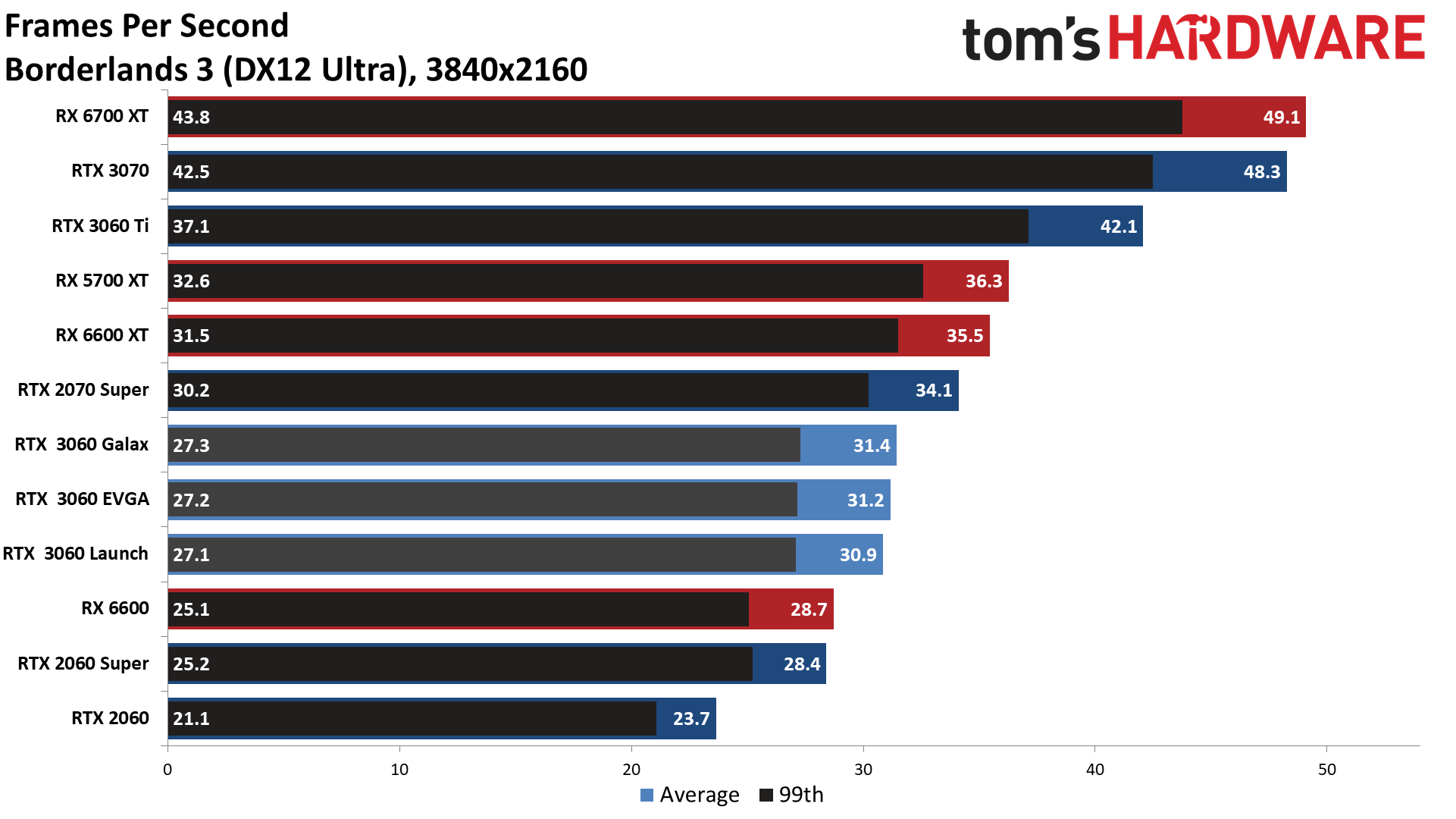

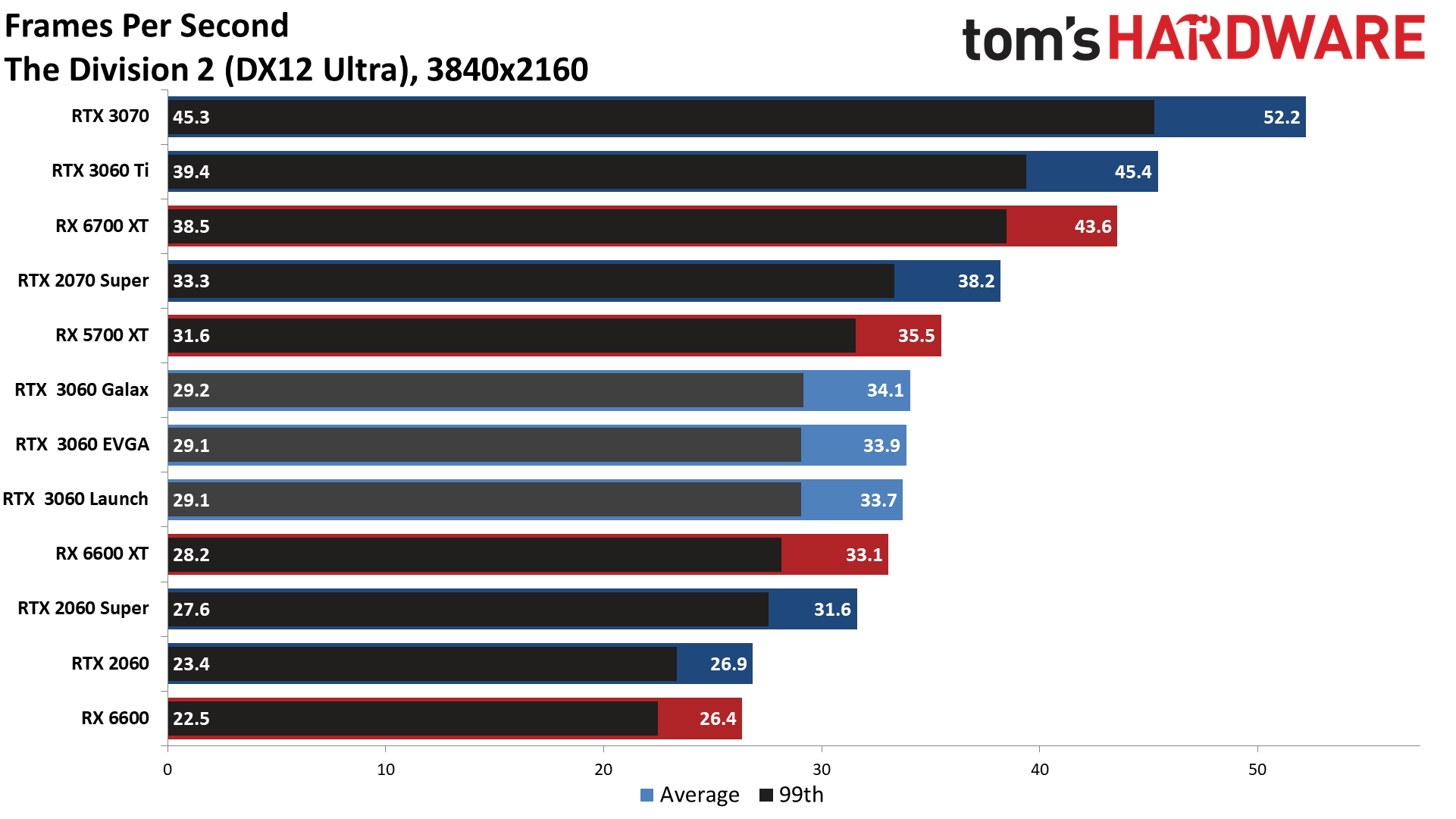


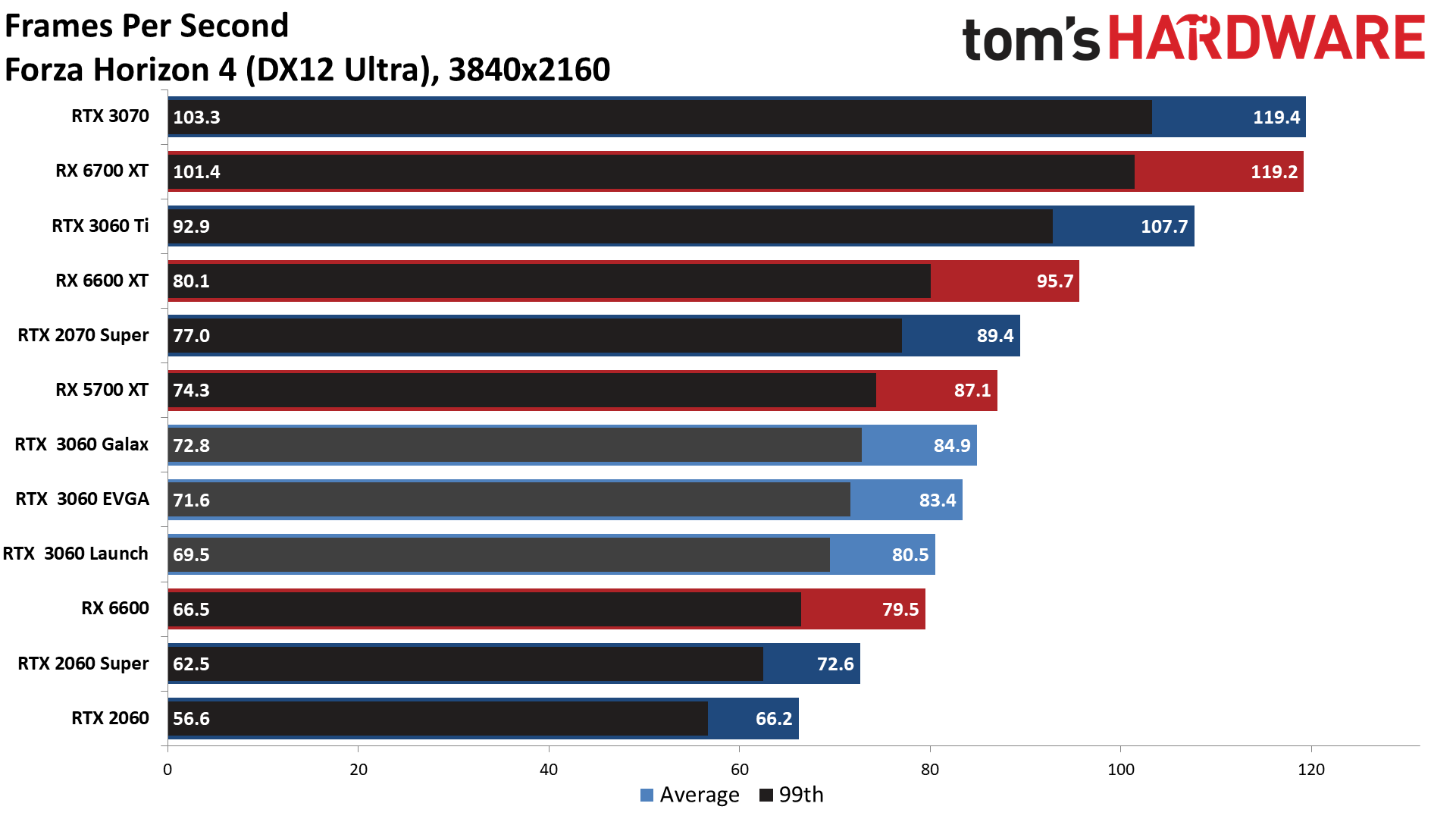
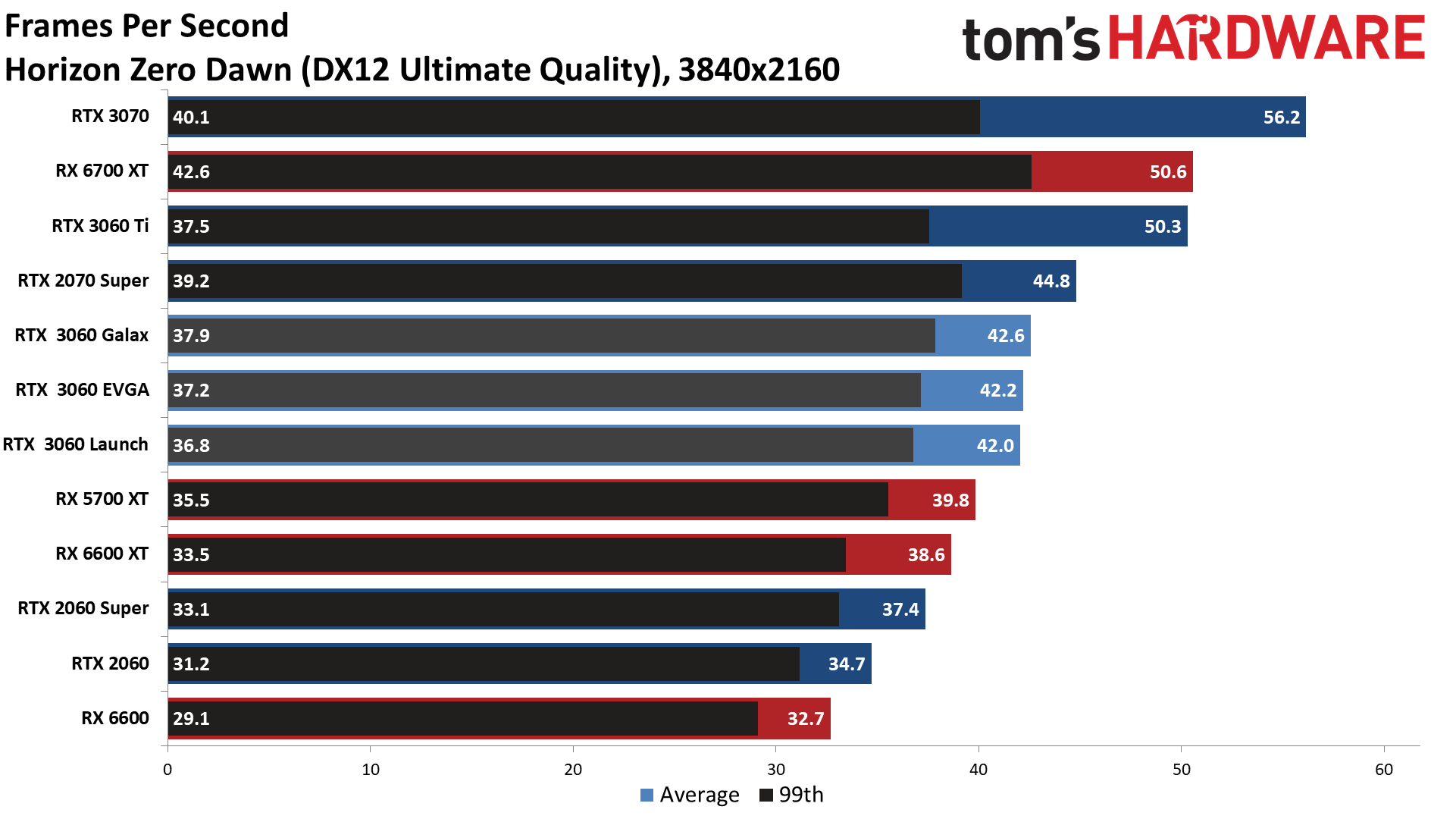
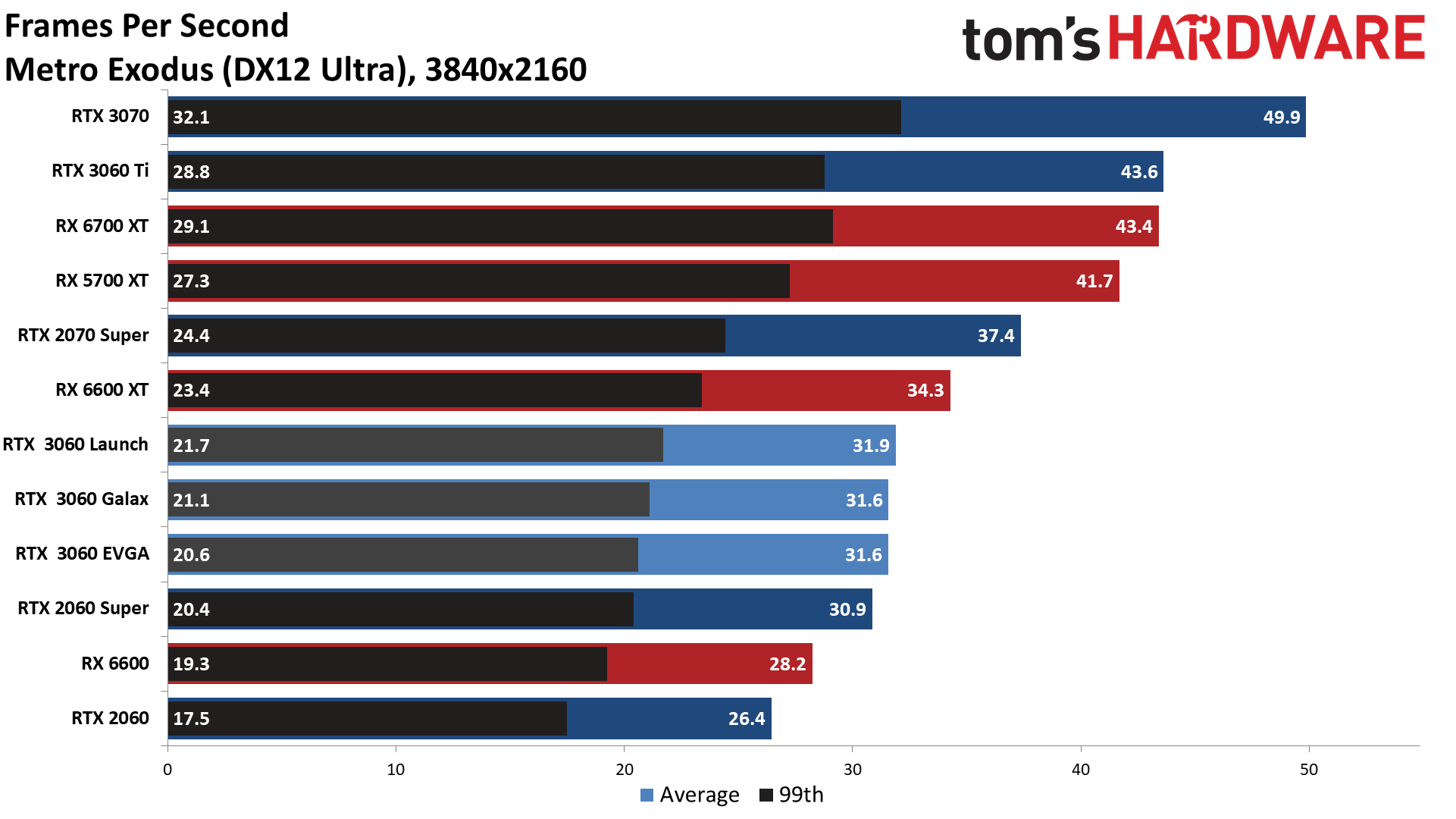
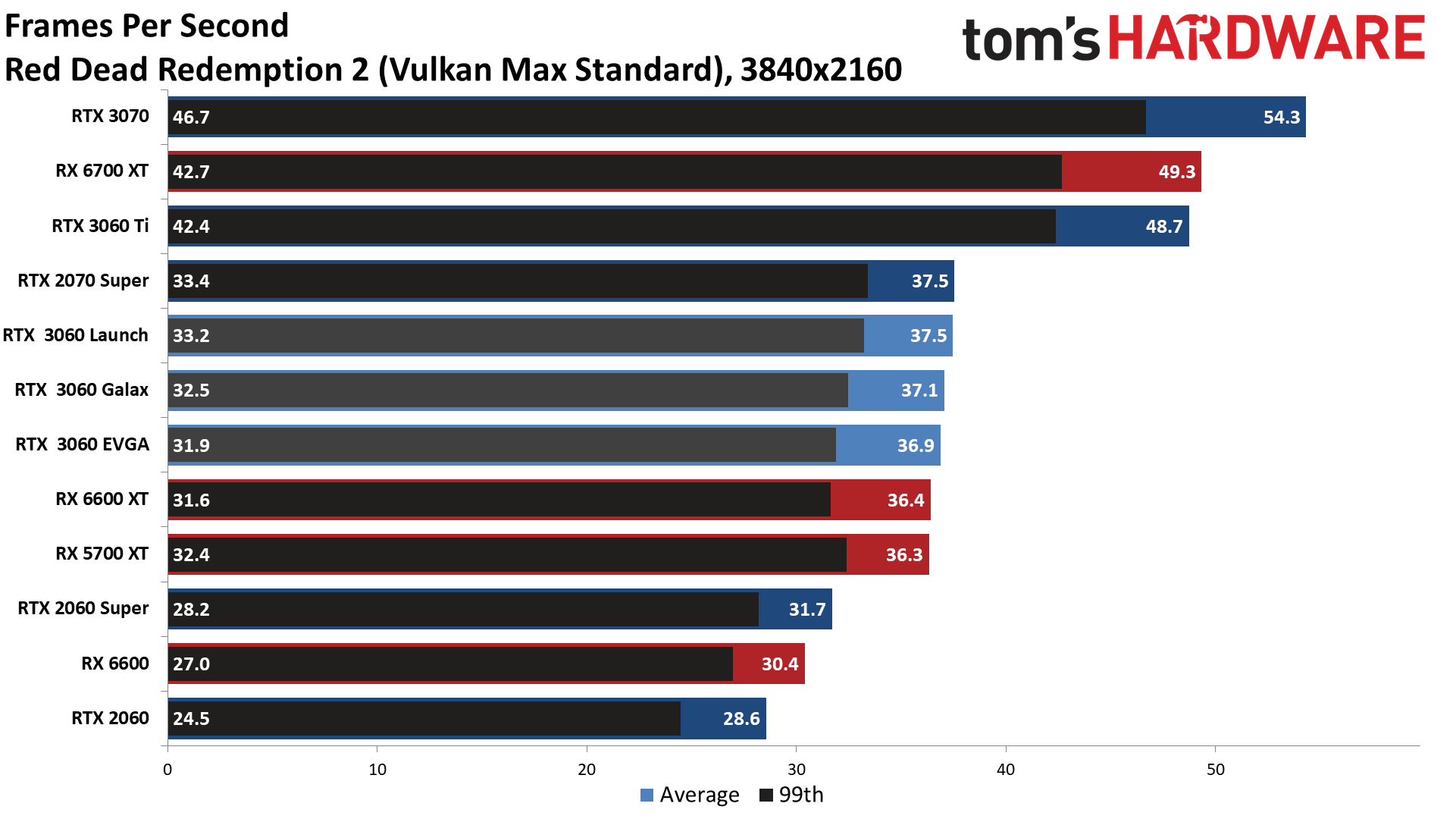
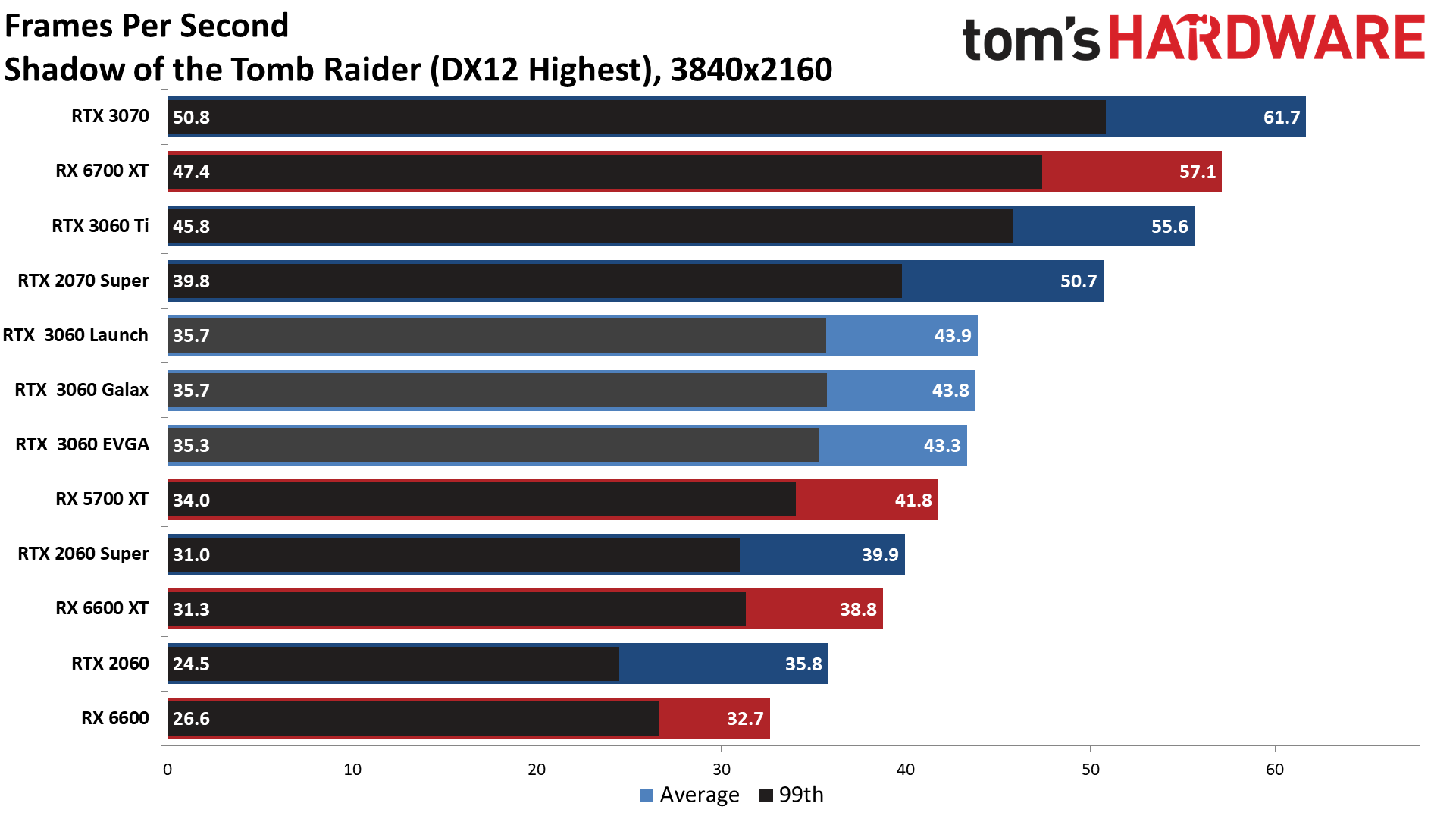
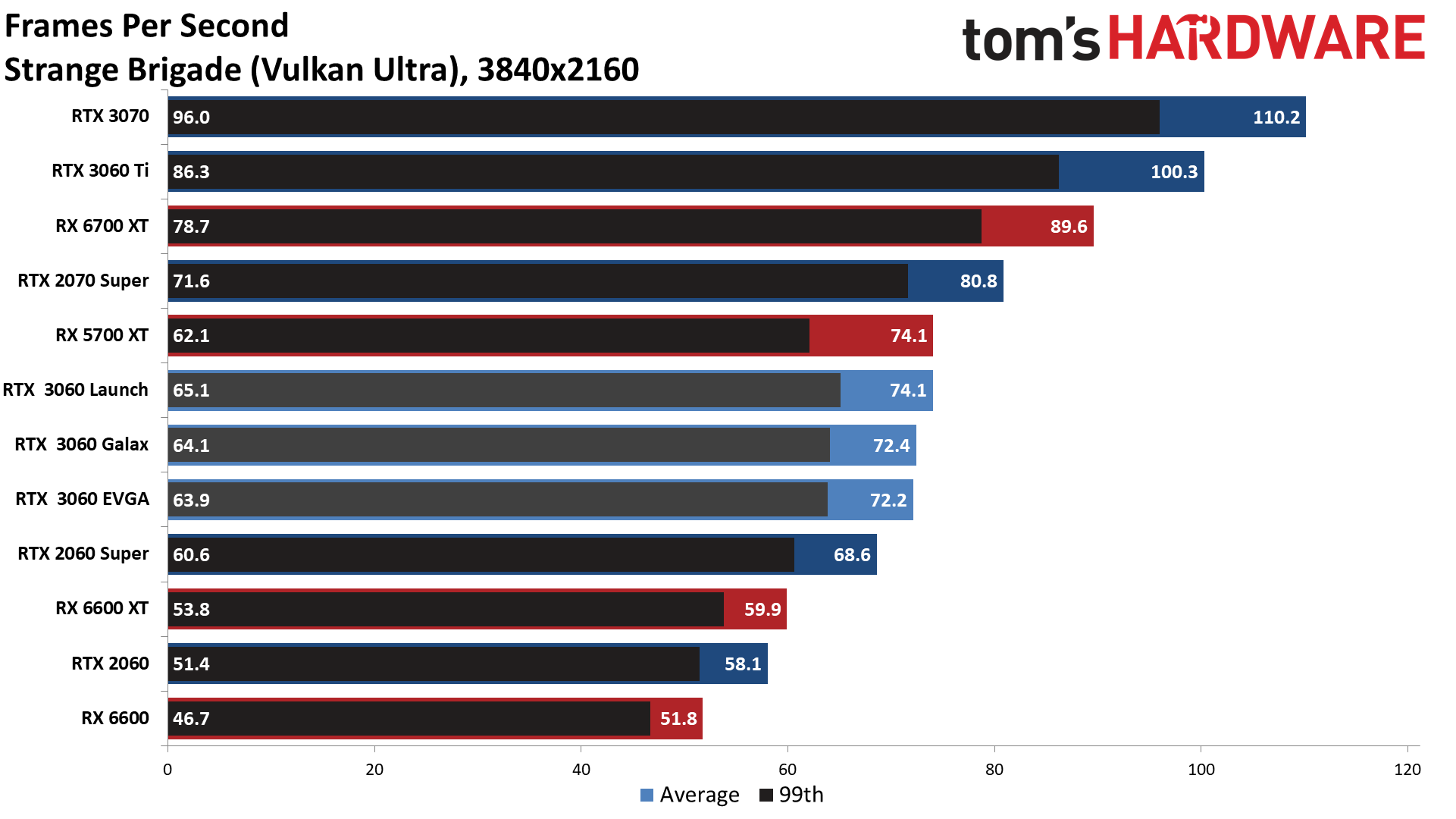
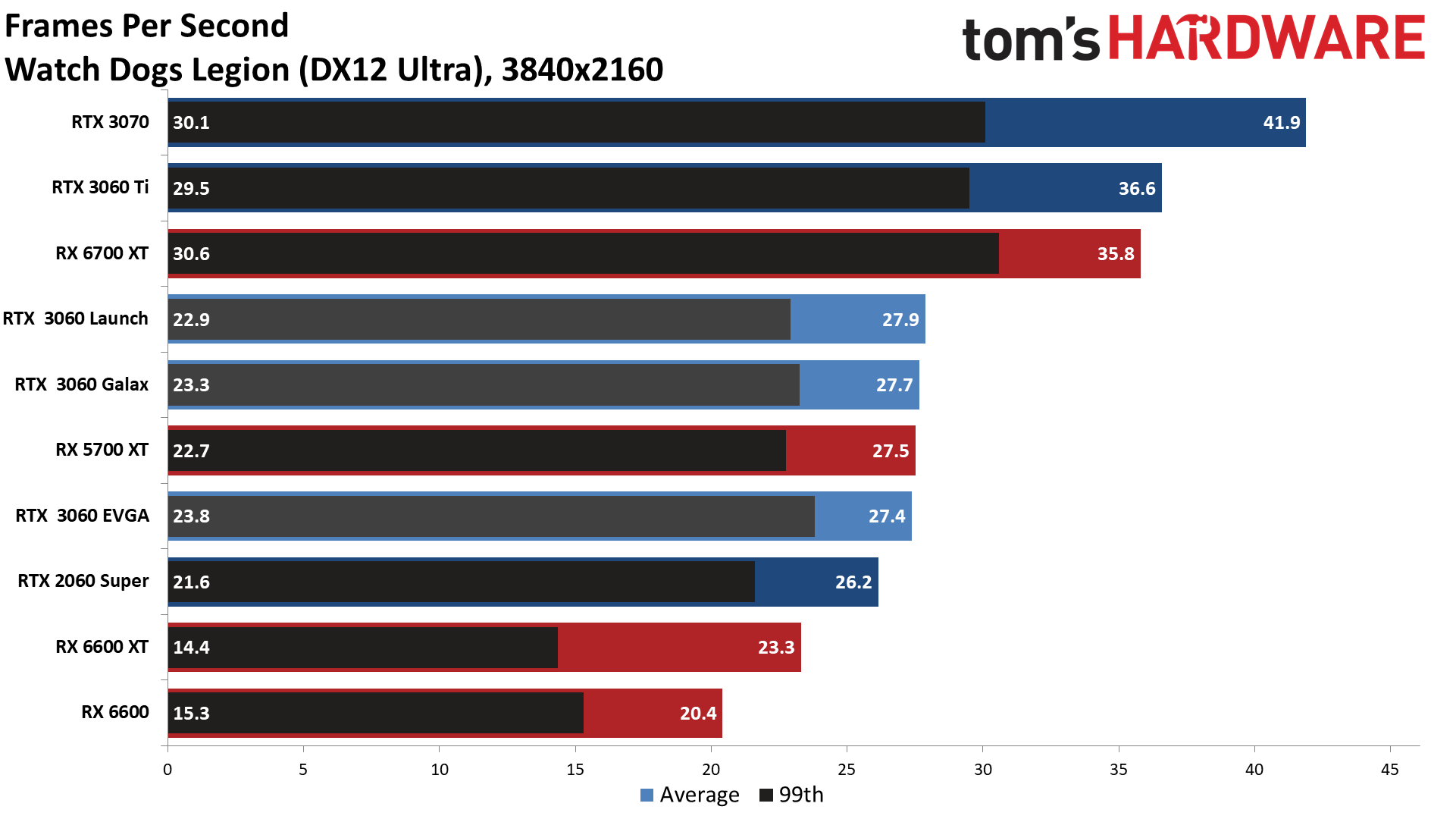
Testing performance at 4K is mostly a formality, as mainstream GPUs like the RTX 3060 aren't really designed for such workloads. Unless you're okay with anything over 30 fps, in which case the Galax card managed that hurdle in 12 of the 13 games, with Watch Dogs Legion being the sole exception — and DLSS would fix that. But the overall average at 4K ultra was only 42 fps, and six of the games average less than 40 fps. Forza Horizon 4 and Strange Brigade were the only titles to break 60 fps at ultra settings.
The Galax card maintains its 1% lead over the EVGA card, and it's now 22% faster than the RX 6600 and even manages to beat the RX 6600 XT by 2%. It's still 23% slower than the RTX 3060 Ti, so it's really the lack of scaling on the 32MB Infinity Cache and the lack of memory bandwidth that's holding the AMD GPUs back. The next step up from AMD, the RX 6700 XT, fixes both of those things and is 34% faster than the Galax card.
It's not that you can't play games at 4K on the RTX 3060, but it will definitely require compromise on settings and fps targets, depending on the game. Lighter games and older releases should be fine, but while 12GB VRAM should be more than sufficient for 4K gaming, the GPU itself isn't quite potent enough to handle that resolution in newer releases.
Galax GeForce RTX 3060 Power, Temps, Noise, Etc.
The Galax GeForce RTX 3060 sticks to Nvidia's 170W TDP rating, and our Powenetics testing equipment that measures in-line GPU power consumption proves that point. We also check other aspects of the cards, including clock speeds, fan speeds, noise, and temperatures. We collect data while running Metro Exodus at 1440p ultra and FurMark stress test at 900p.
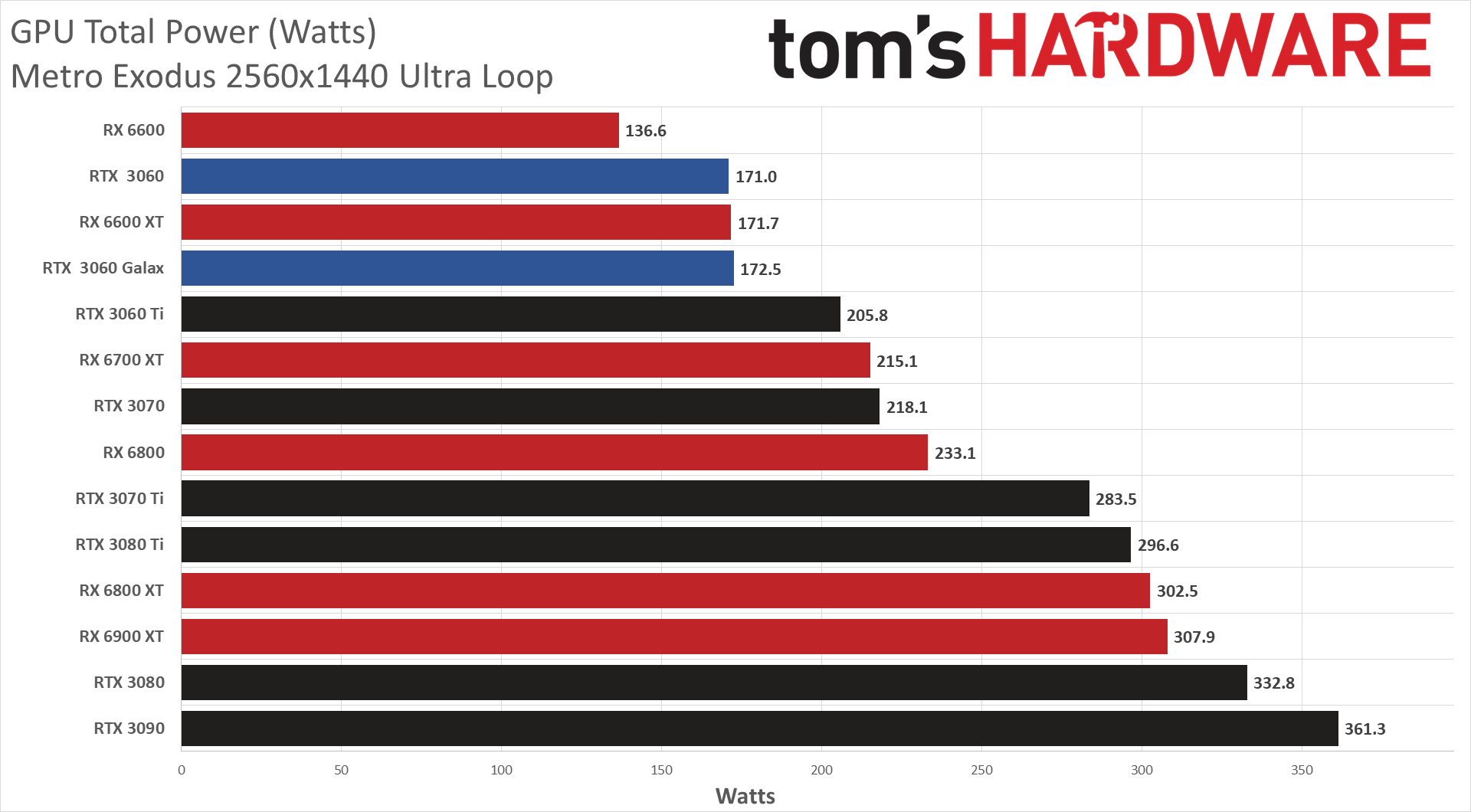
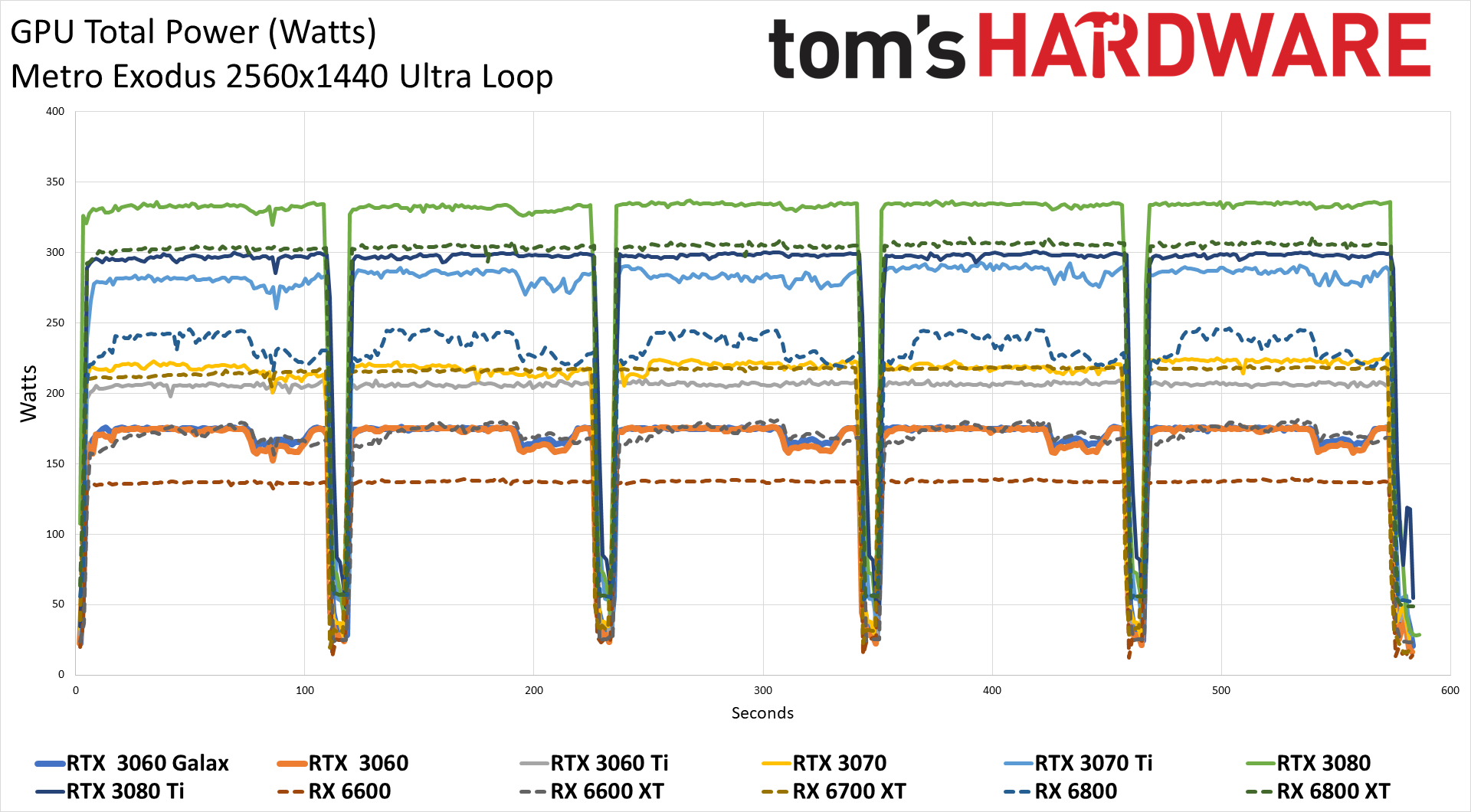
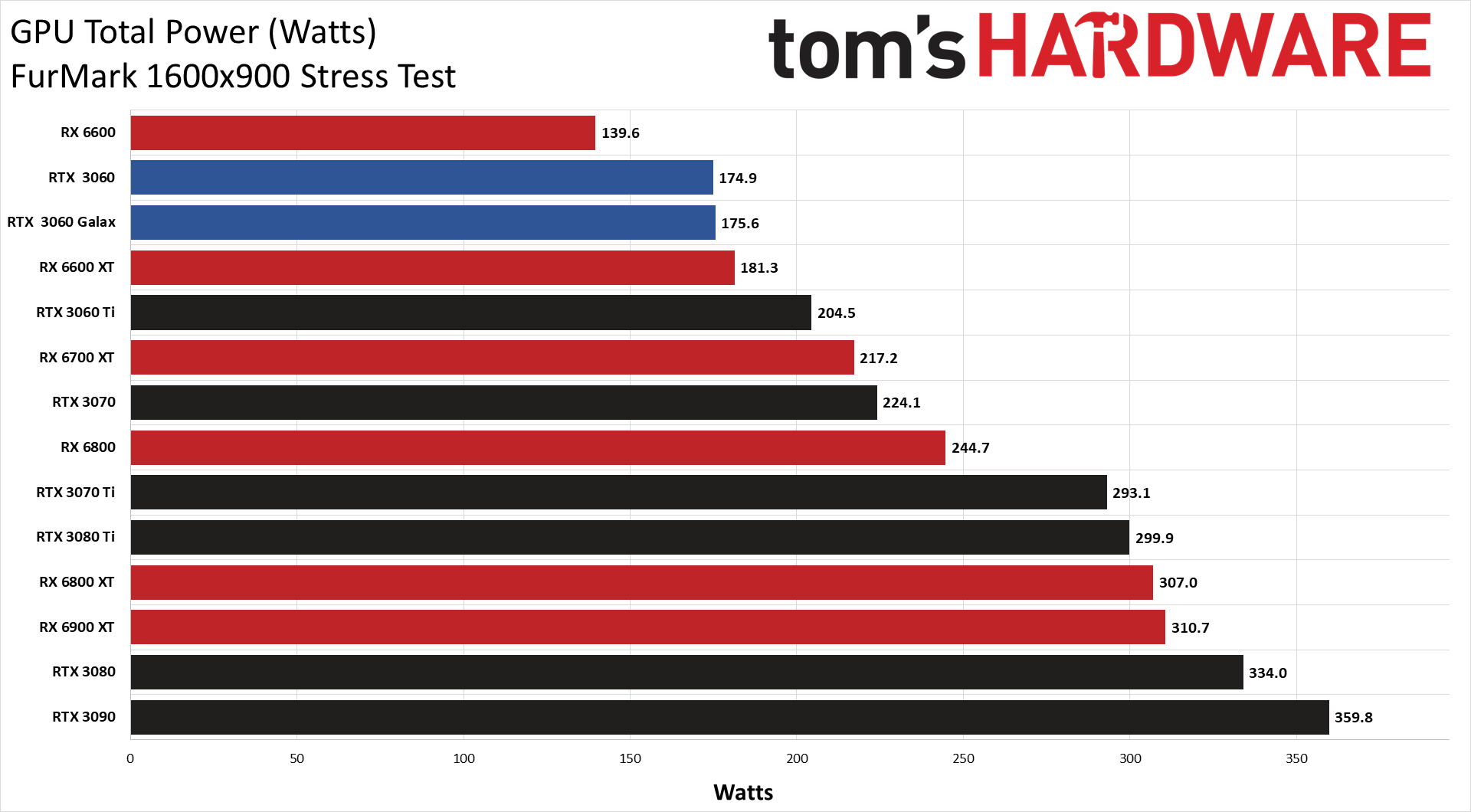
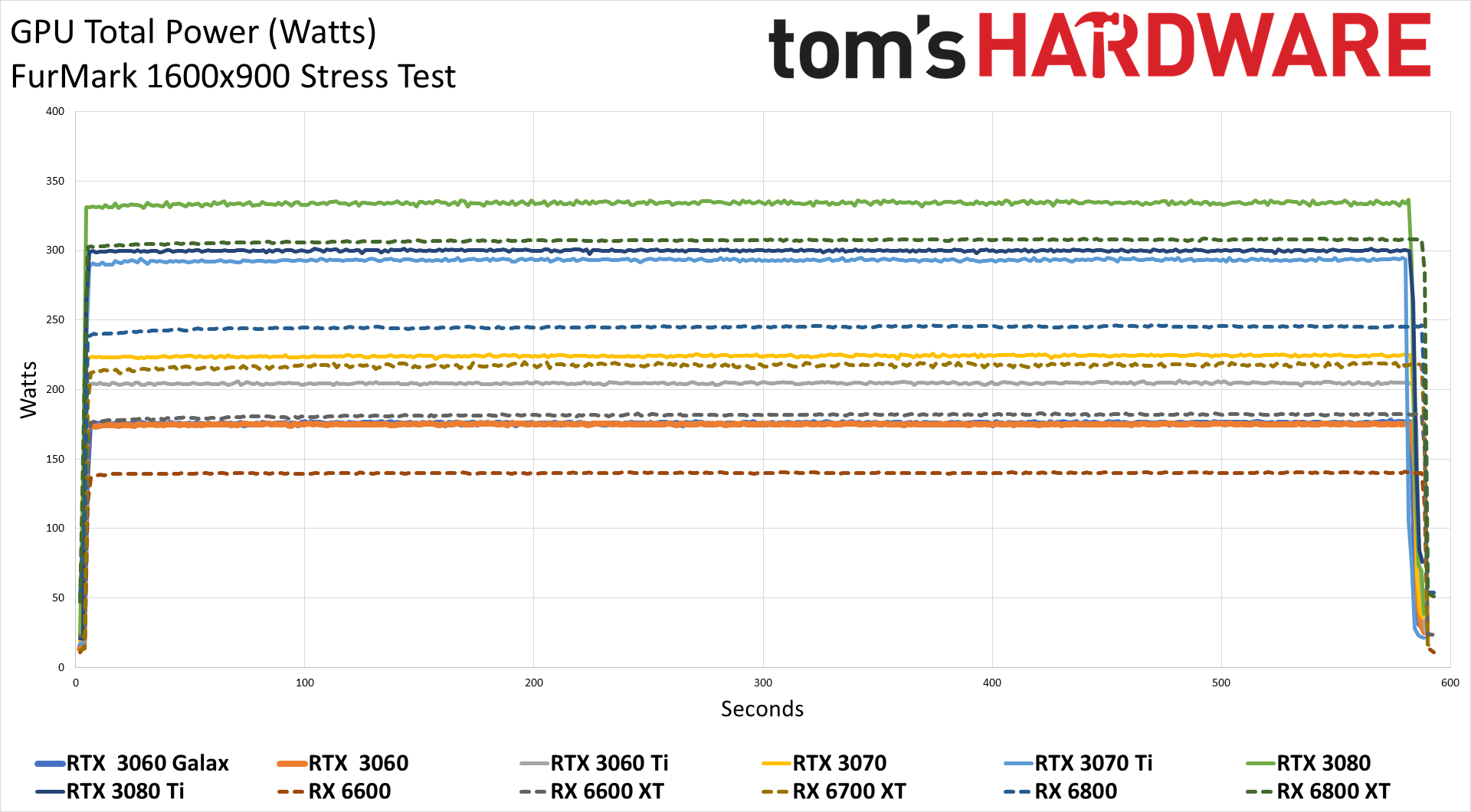
Power use during the Metro Exodus benchmark loop averaged 172.5W, just a hair more than the 170W TDP, but nothing to worry about. Most of that comes via the 8-pin power connector, with peak power use of 57W from the PCIe slot. FurMark used a few watts more, which is pretty typical behavior. That puts the Galax card below the RX 6600 XT by 5–10W, but about 35W above the RX 6600. Since all of those cards typically use a single 8-pin power connector, any PC capable of using one card should be able to work with any of the three.

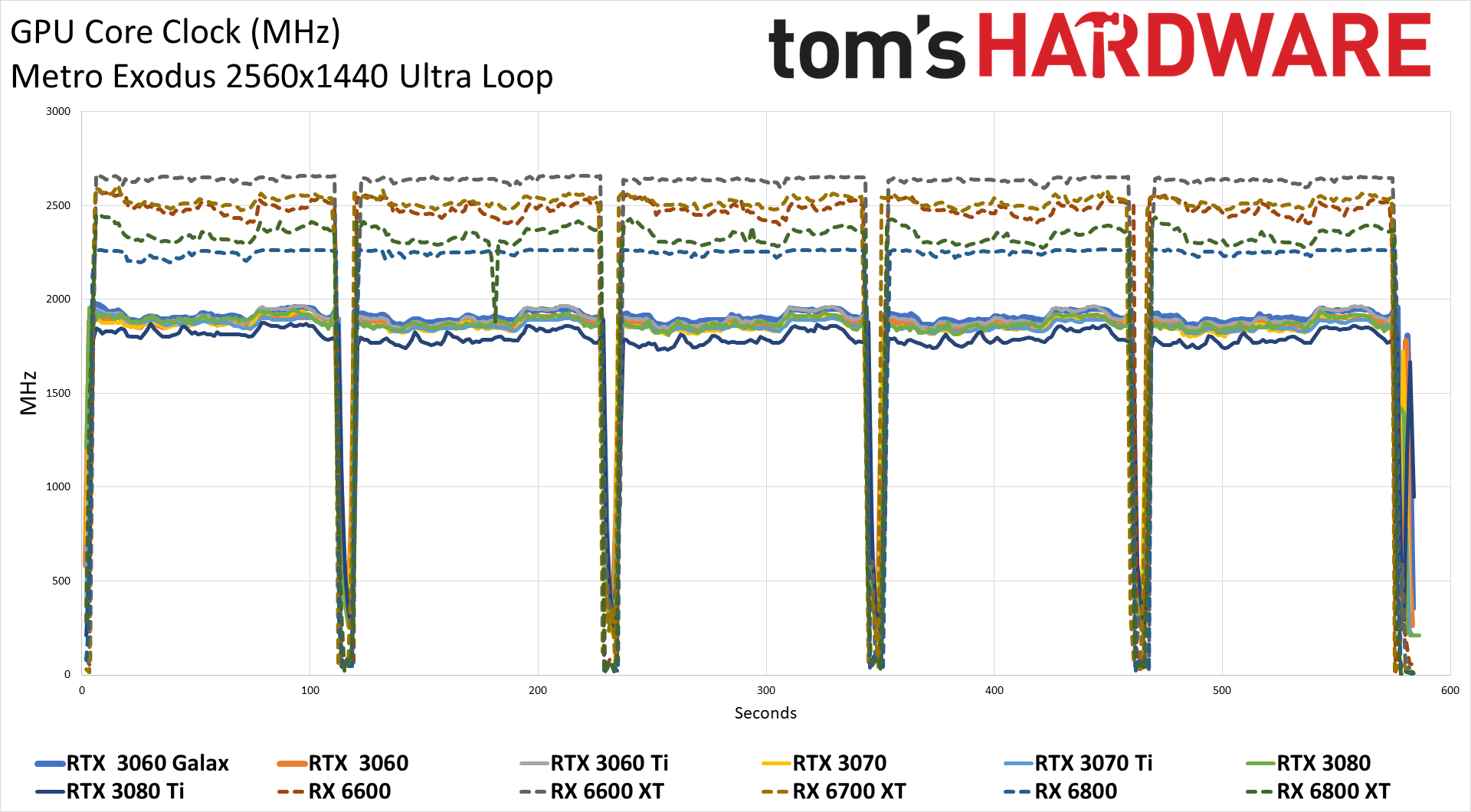
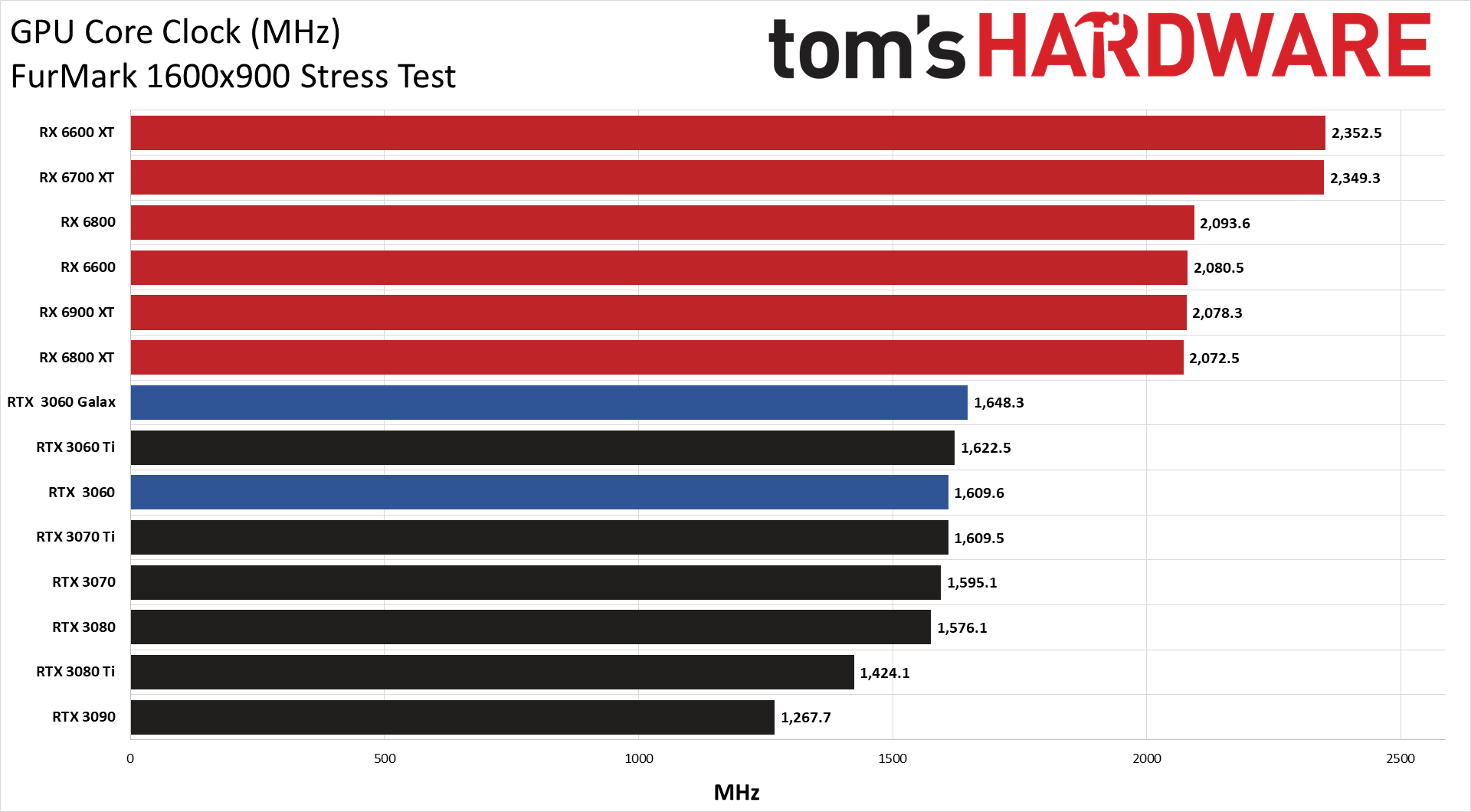
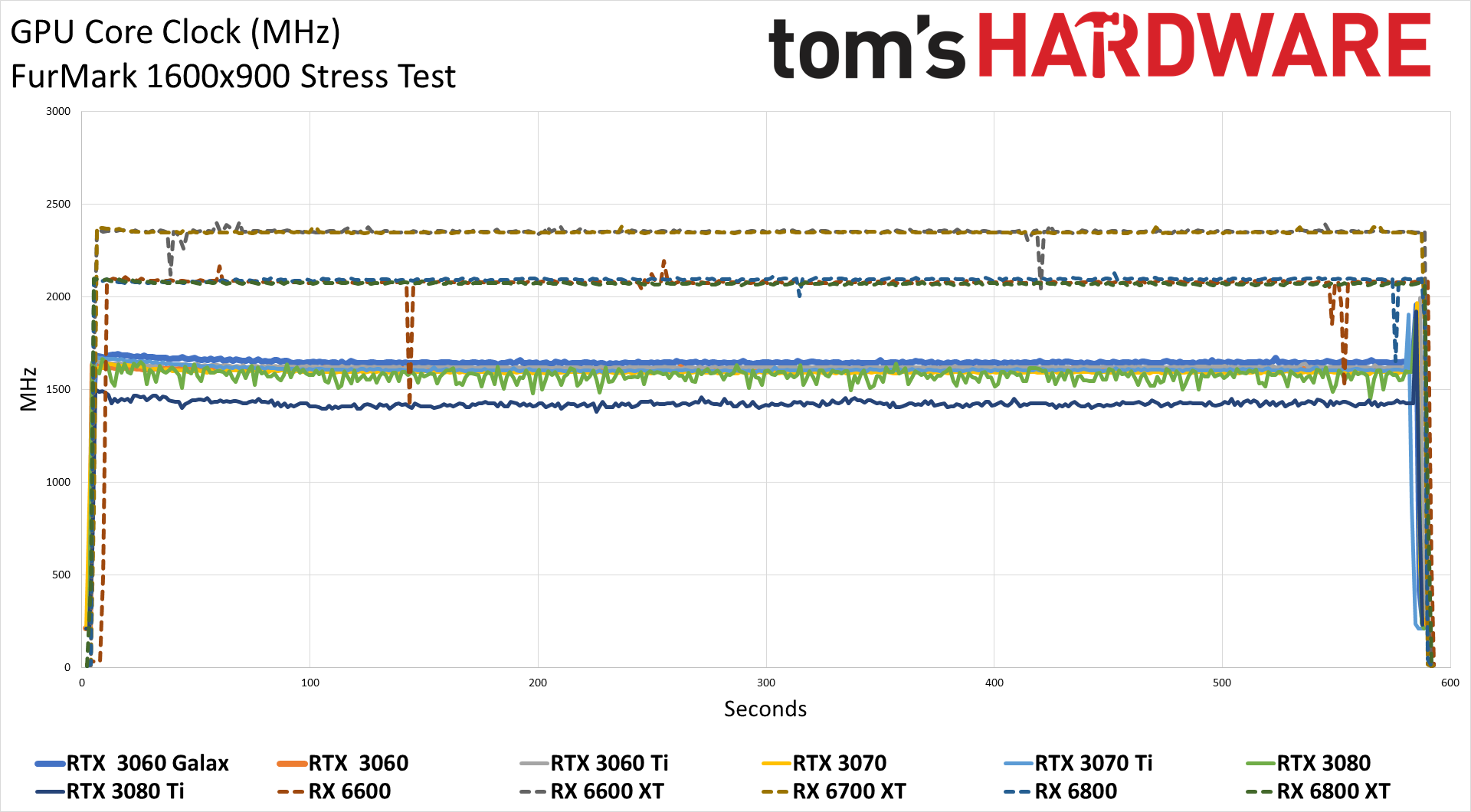
Nvidia's GPU clocks with Ampere are quite a bit lower than AMD's RDNA2 clocks. The Galax card averaged just over 1900 MHz in Metro Exodus, while the RX 6600 ran close to 2.5 GHz and the 6600 XT topped the charts at over 2.6GHz. Clock speeds on their own aren't super useful, of course, unless you're looking at the same GPU. The Galax card was about 30 MHz faster than the EVGA card in our tests, which coincides with the ~1.5% difference in performance that we measured.
Get Tom's Hardware's best news and in-depth reviews, straight to your inbox.
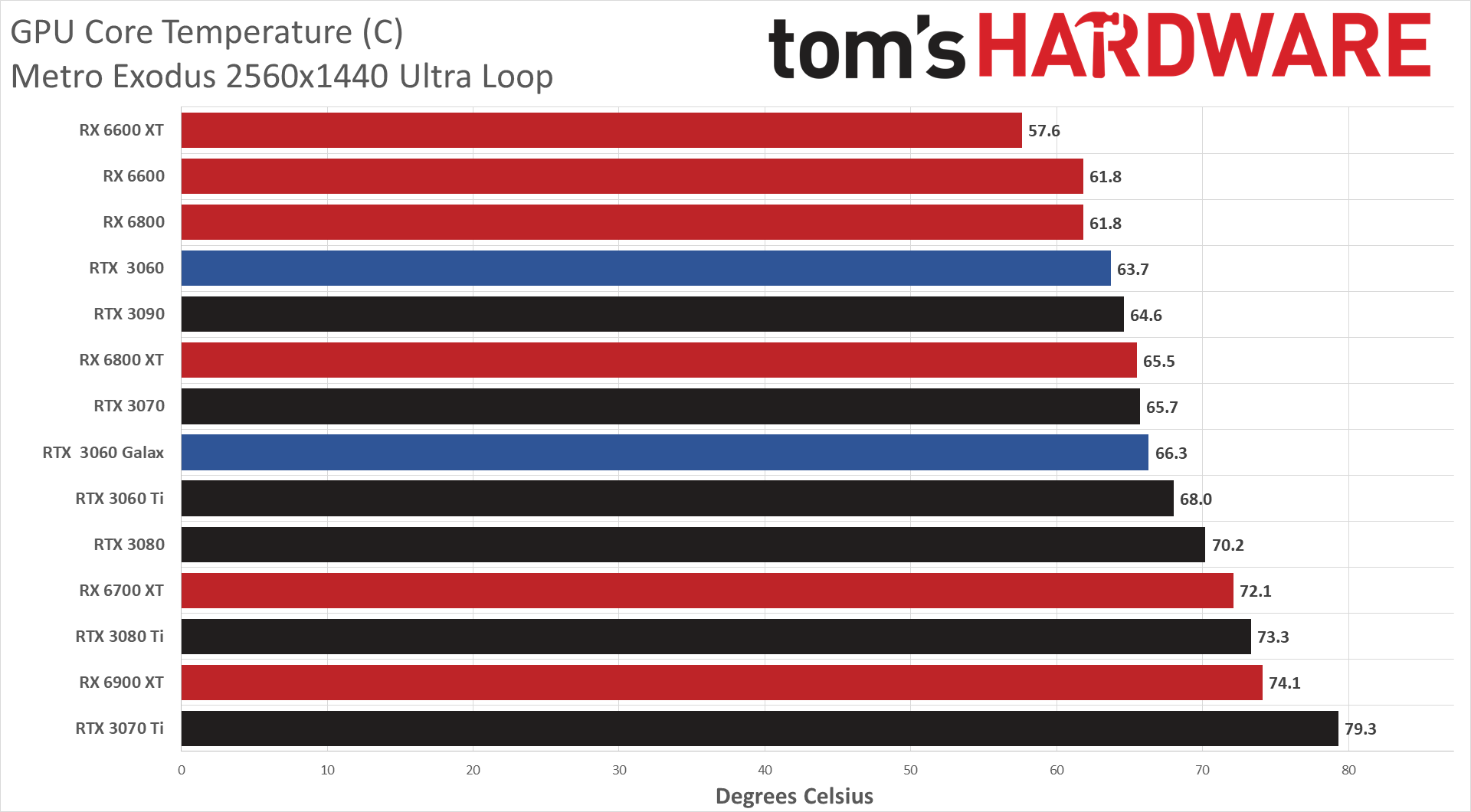
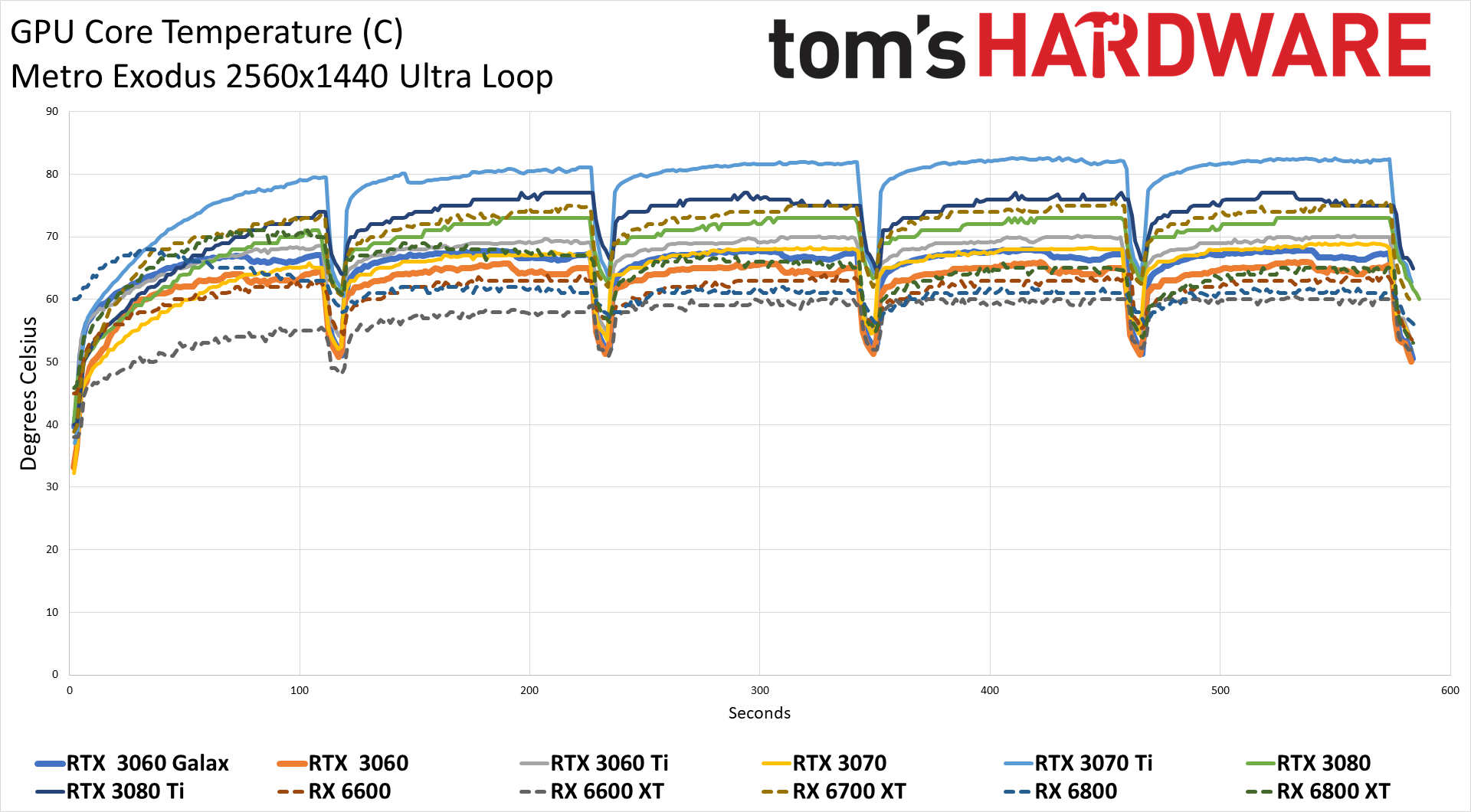
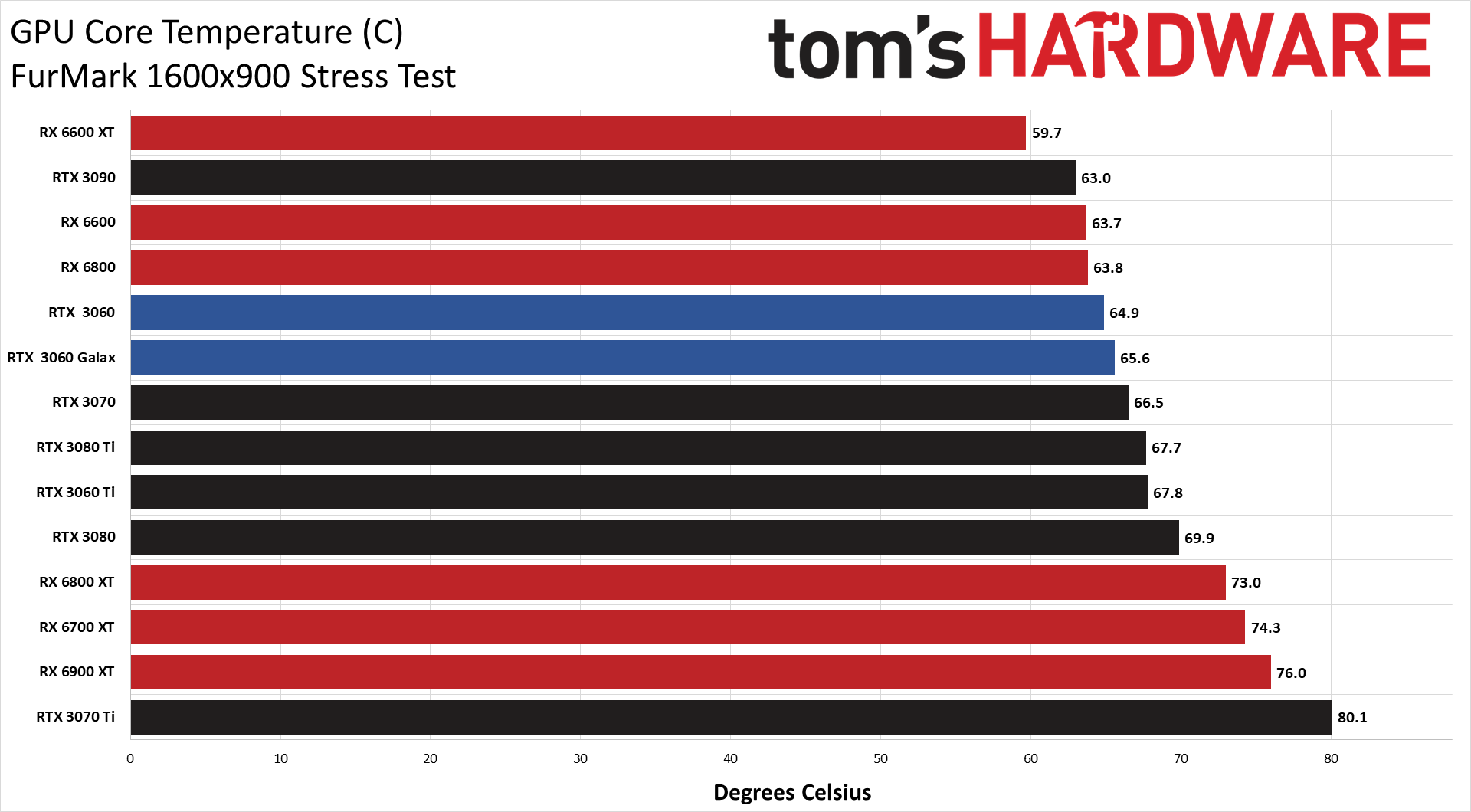

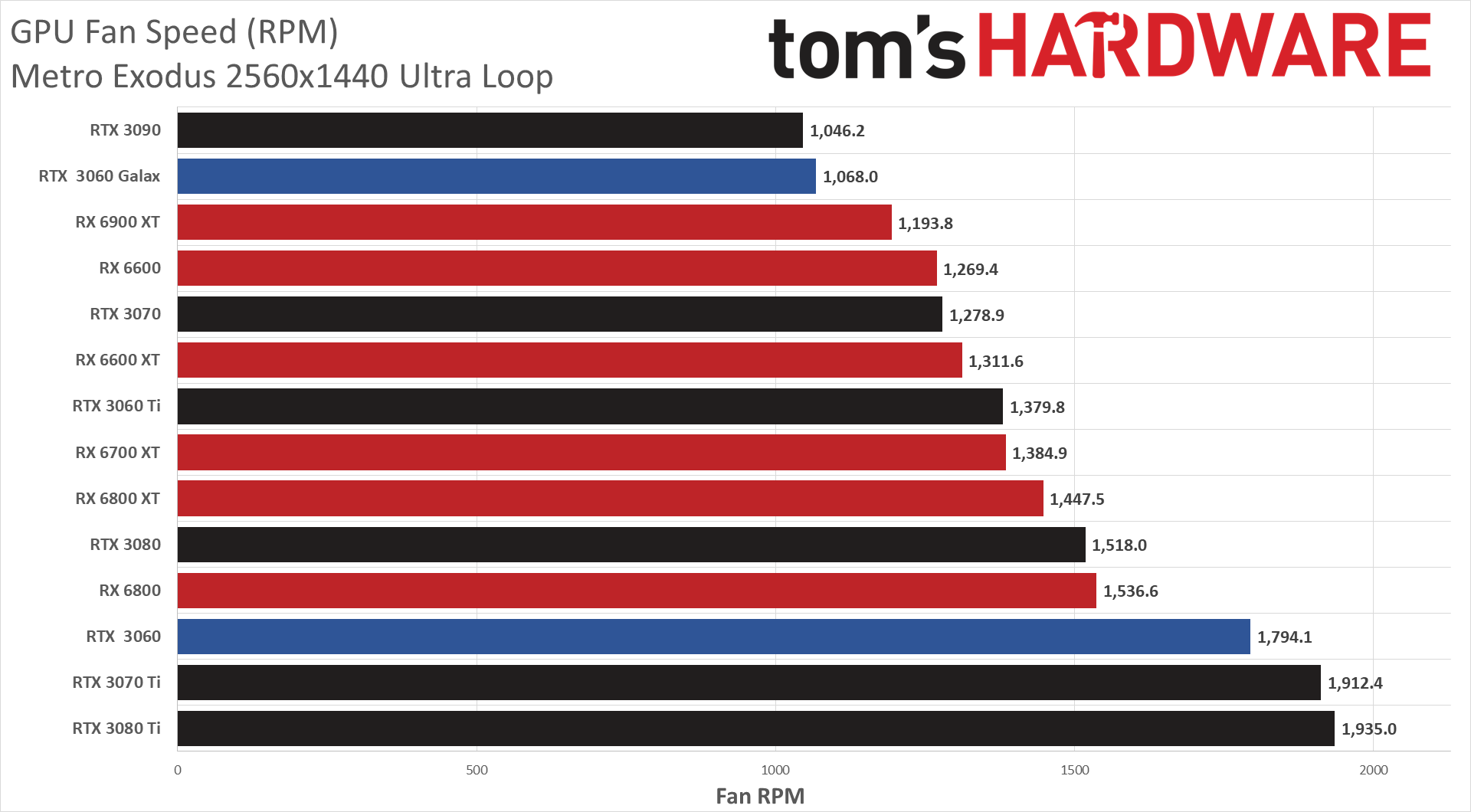
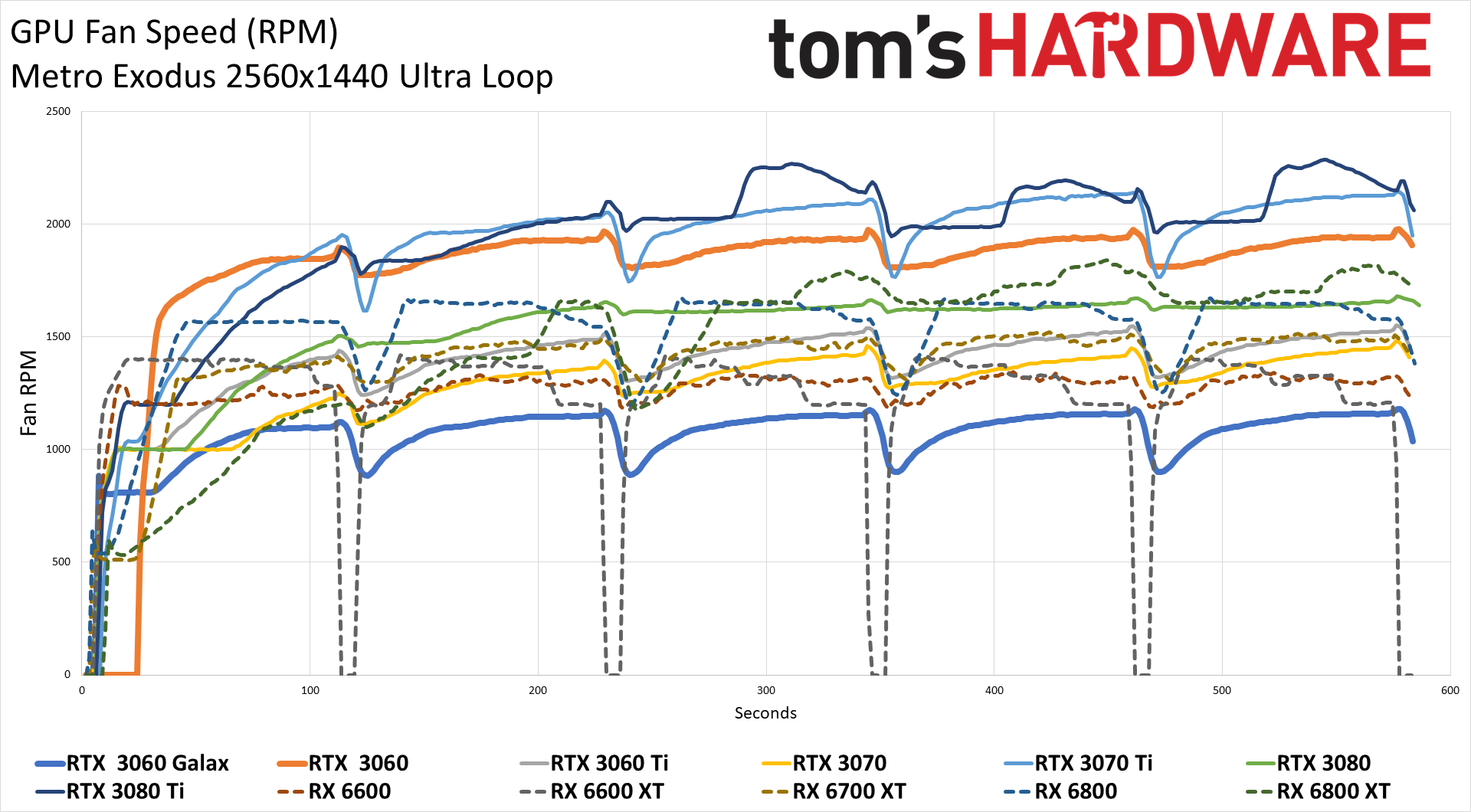

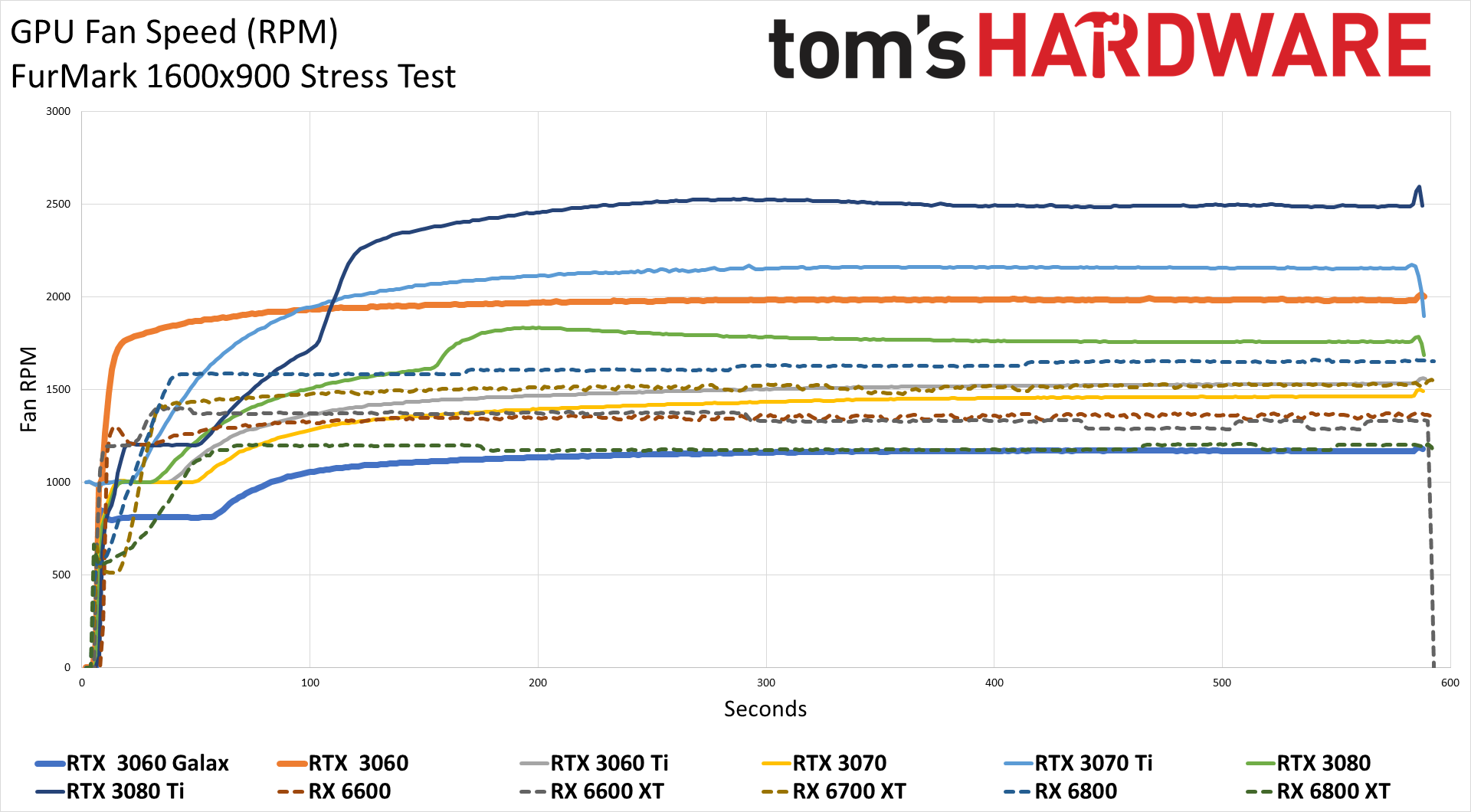
Fan speeds and temperatures go hand in hand, so we need to consider both metrics when looking at cooling performance. The Galax card ran a few degrees warmer than the EVGA card, 66C vs. 63C in Metro, but the fan speed was also substantially lower: around 1075 RPM vs. close to 1800 RPM on EVGA. In FurMark, the fan speed gap widens, with the Galax card at around 1100 RPM and the EVGA at around 1950 RPM, with less than a 1C difference in temperature. It's pretty obvious that the larger Galax cooler and fans lead to better cooling performance.
We also measure noise levels at 10cm using an SPL (sound pressure level) meter. It's aimed right at the GPU fans, in order to minimize the impact of other fans like those on the CPU cooler. The noise floor of our test environment and equipment measures 33 dB(A), and the Galax card ran at a very quiet 39.6 dB(A) — again, from extremely close range. Even with the fan speed set to a fixed 75%, the card only generated 51.5 dB of noise. The EVGA card by comparison ran at about 44 dB in our gaming tests, and there wasn't a lot of headroom to go higher as the fans were already running at 71%.
Galax GeForce RTX 3060 Mining Performance

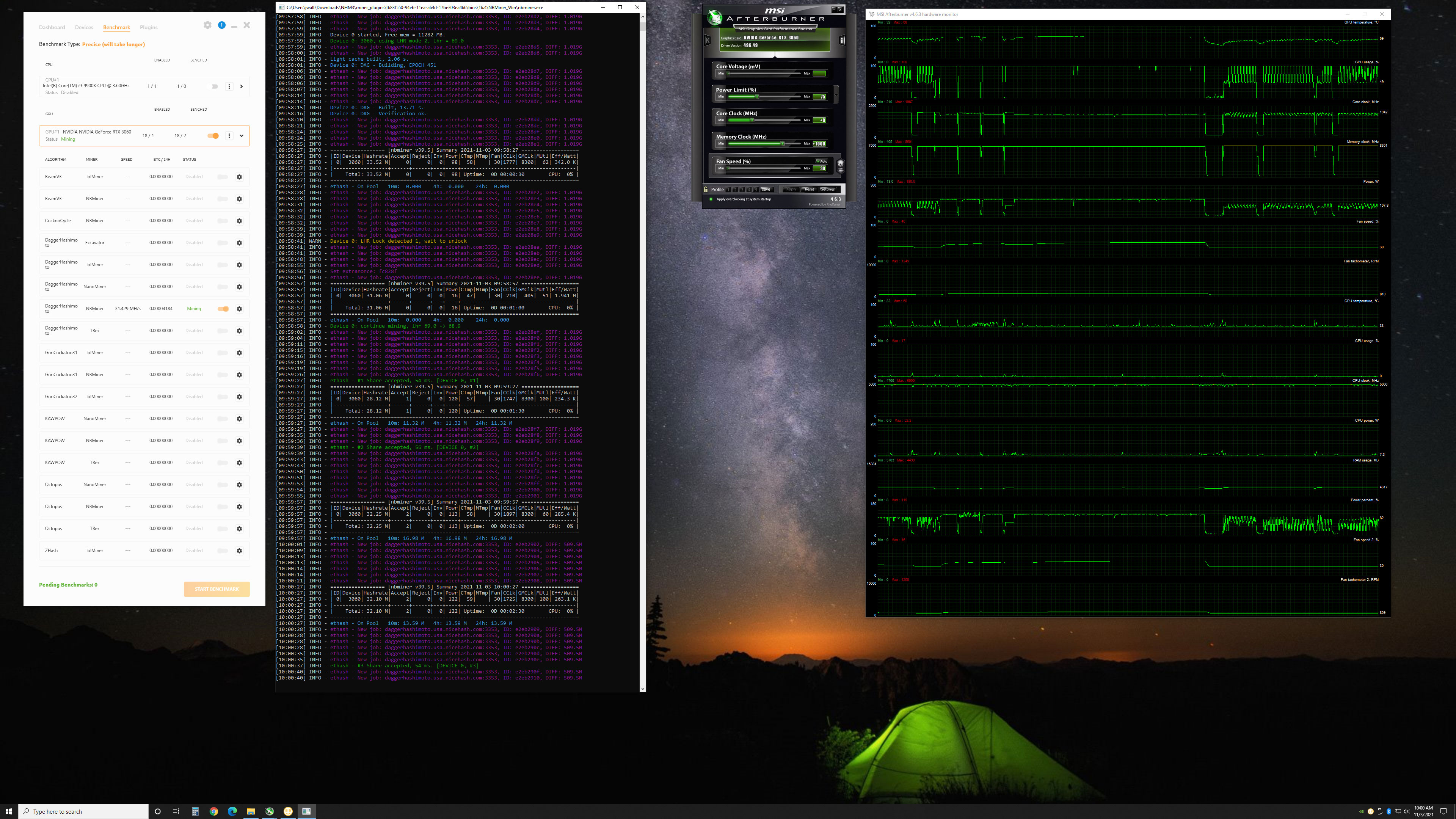

Ethereum mining continues to have an impact on GPU prices, and while the original RTX 3060 was the first series of Nvidia Ampere GPUs to come with a hashrate limiter, that was later cracked. The Galax card includes the updated firmware that locks things down again, but updated versions of various mining software have at least partially overcome those limits. We ran some tests to see how the Galax 3060 fares, using NiceHashMiner to check mining performance with a variety of algorithms.
At stock clocks, KAWPOW mining using NBMiner delivered the best profitability, of around $2.60 per day (minus power). The Ethereum hashrate with NBMiner was around 28 MH/s. Setting the memory clocks to +1000 MHz (16.6 Gbps effective while mining) and putting the power limit at 75% resulted in Ethereum hashrates of 32.4 MH/s, which was quite a bit lower than the 48 MH/s we achieved with a non-LHR 3060. A bit more tuning, with the VRAM at 17.6 Gbps effective (+1500 MHz, the maximum allowed) and a 70% power limit got us to 34.2 MH/s while drawing an average (real power measurement via Powenetics) of 107W.
Basically, mining performance was slightly higher than the RX 6600 XT, while using a bit more power. Considering the going price of RTX 3060 cards on eBay (around $700 right now), it would take about 250 days to break even — assuming prices and difficulty don't change, which of course will never be correct. Unfortunately, it's pretty clear that mining continues to have a strong impact on GPU prices and availability.
Galax GeForce RTX 3060: A Good Card That's Hard to Find
If the GeForce RTX 3060 were available at anything close to Nvidia's official starting price of $329, it would be an excellent bargain. Performance that's better than the previous generation RTX 2070 for about $170 less money? Sign us up! But then the miners came along and decided that was just too good a deal to pass up, and now virtually all the cards get sold at more than double the official MSRP.
AMD's competing RX 6600 isn't doing much better, with worse performance but lower street prices. The average price on eBay during the past week was 'only' $555, a real bargain compared to $700 for the RTX 3060, but gamers shouldn't pay more than maybe $400 for this level of hardware. Just wait it out, try to borrow an older model GPU if necessary, and at some point the situation should improve.
It's a shame, because other than real-world pricing and availability, there's a lot to like in the Galax RTX 3060 EX. It runs cool and quiet and performs slightly better than other RTX 3060 cards, and it has RGB lighting on both fans for people that want that sort of thing. Galax informed us it will be doing giveaways and prizes on GalaxStore.net, but I haven't seen any prizes so far. It's free to register if you want yet another account, and you can currently find the RTX 3070 Ti bundle in stock for $1,000, but the RTX 3060 we're reviewing isn't currently listed.
Updated test results for the RTX 3060 did improve a bit compared to launch performance, which was also good to see. That was mostly in a few games that favored AMD GPUs more, at least for our test suite, but if you happen to be an Nvidia user and currently play one of those games — Assassin's Creed Valhalla in particular — you can feel a bit better about how team green stacks up to its competition. Not that it really matters, as the best graphics card right now is the one you can actually find for a reasonable price, and that eliminates pretty much everything.
When will things change, to the point where it's possible to shop at Amazon or Newegg or some other website and find cards priced at MSRP in stock and ready for purchase? If I were a betting man, I wouldn't count on that happening before 2023. By then we should have the successors to both Ampere and RDNA2, but don't be shocked when those launch at higher price points than the current models.
MORE: Best Graphics Cards
MORE: GPU Benchmarks and Hierarchy
MORE: All Graphics Content

Jarred Walton is a senior editor at Tom's Hardware focusing on everything GPU. He has been working as a tech journalist since 2004, writing for AnandTech, Maximum PC, and PC Gamer. From the first S3 Virge '3D decelerators' to today's GPUs, Jarred keeps up with all the latest graphics trends and is the one to ask about game performance.
-
tacgnol06 3 generations and 4 years later this barely matches the used GTX 1070ti I bought at a bargain from an Etherium seller after that crashed, plus I couldn't buy it even if I really wanted RTX support that badly. Kinda depressing.Reply
Card still works btw and powers my Valve Index setup, don't believe everything you read about used crypto cards being unusable for gaming.

